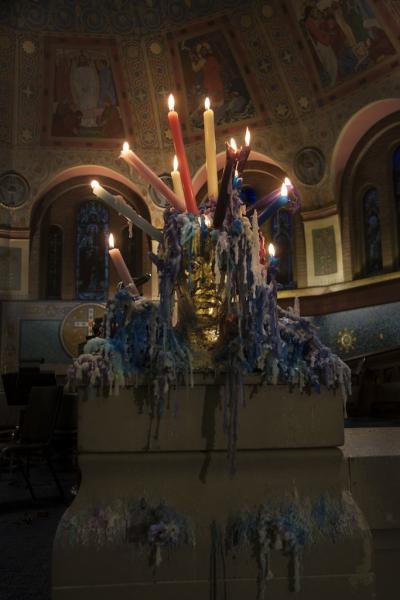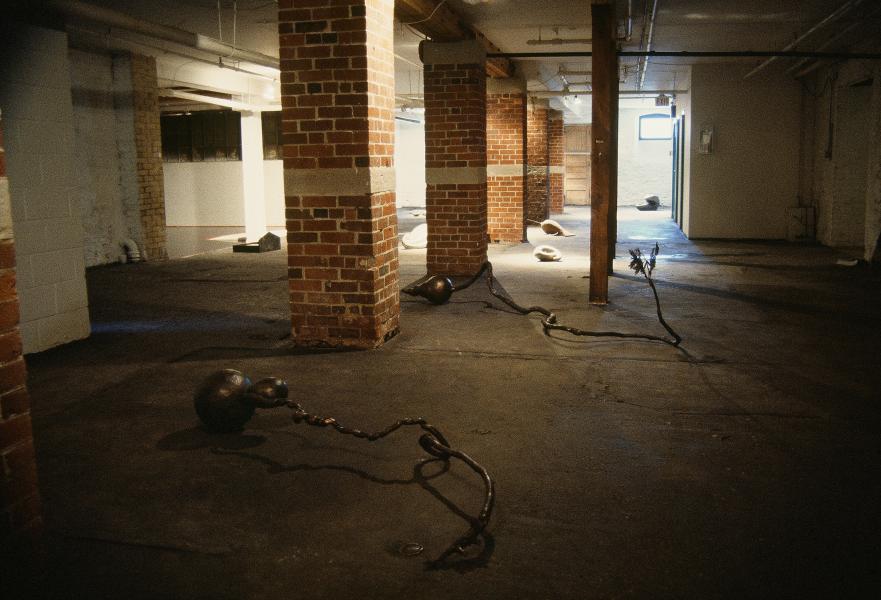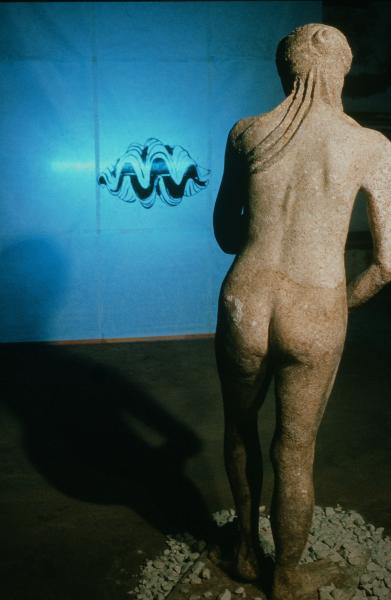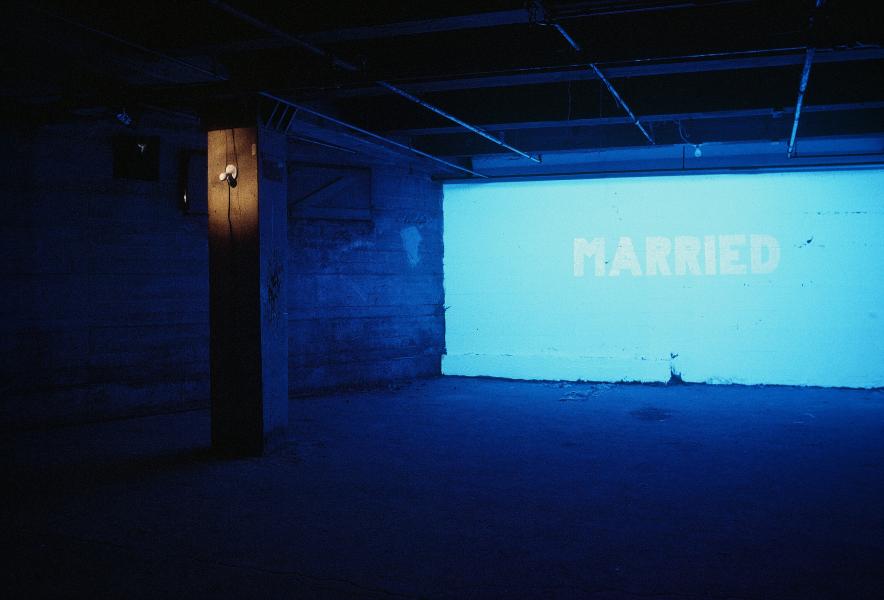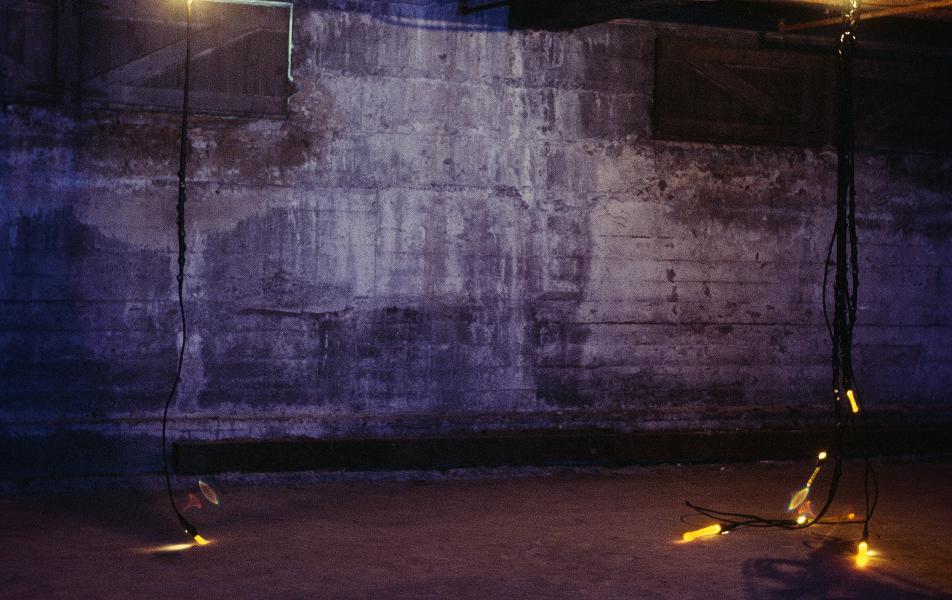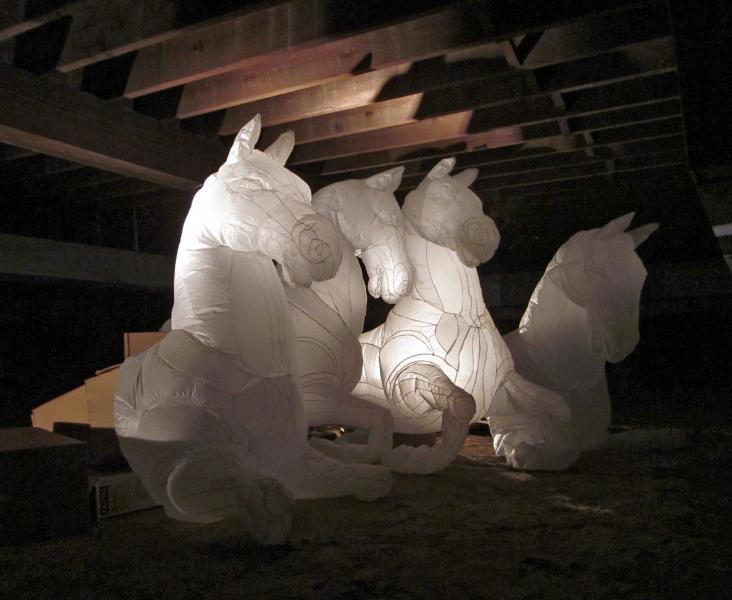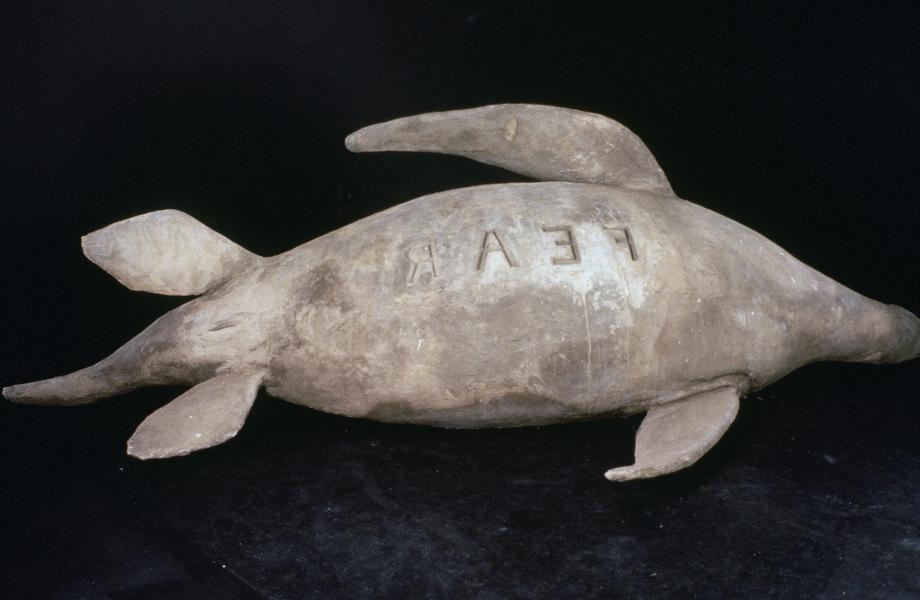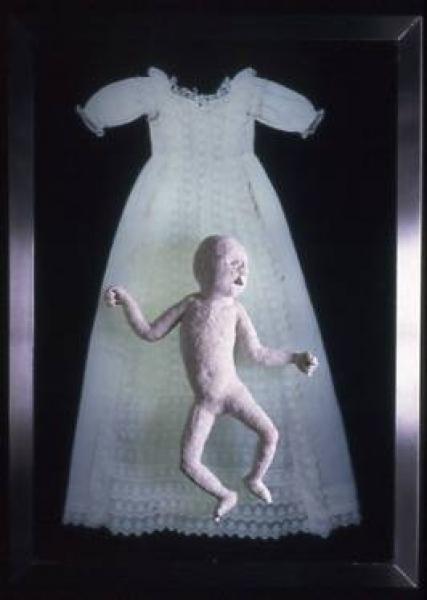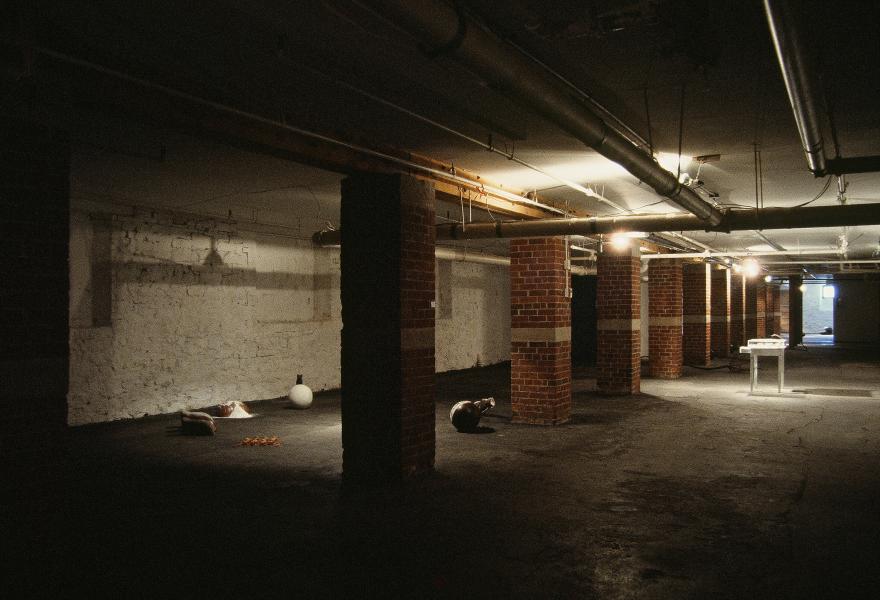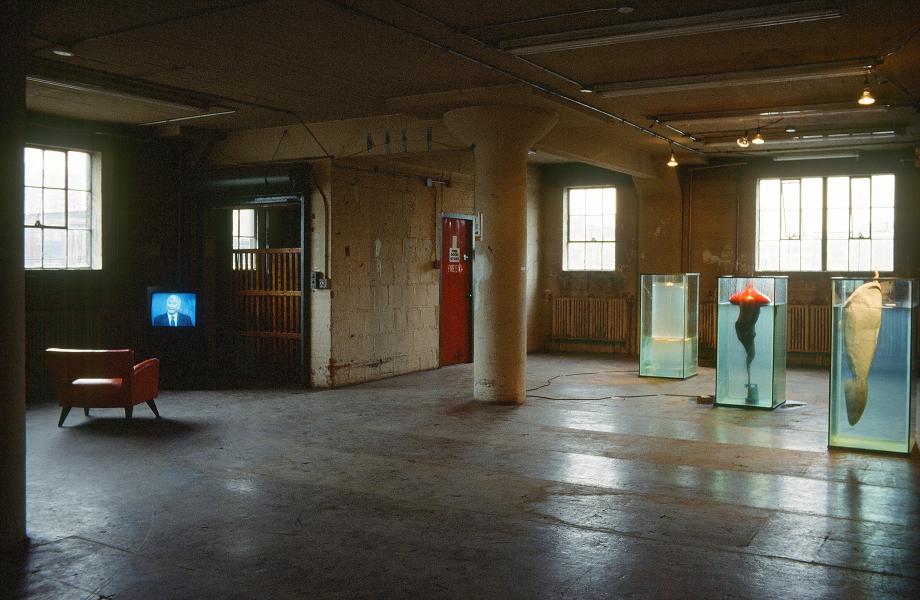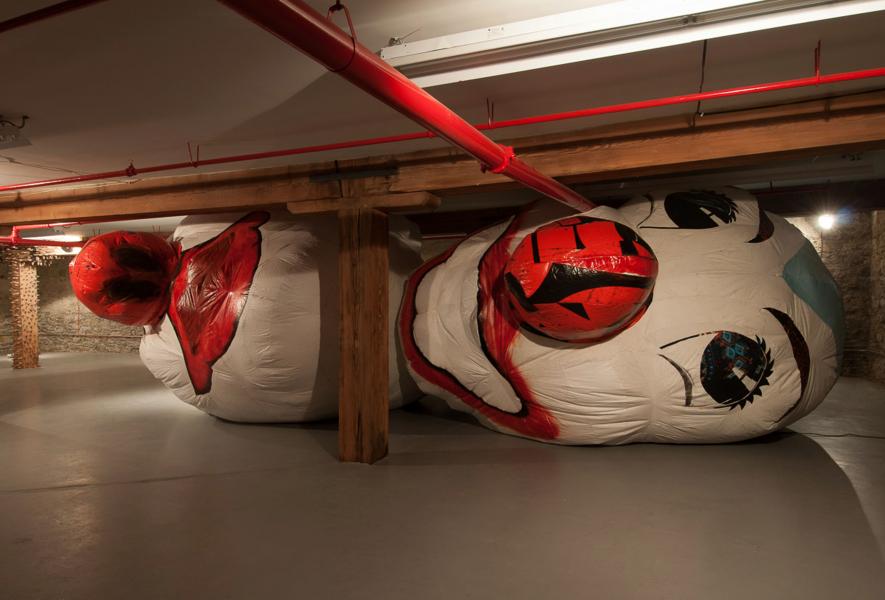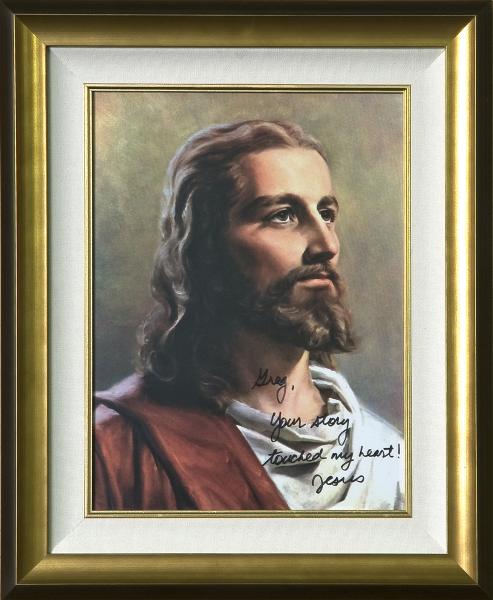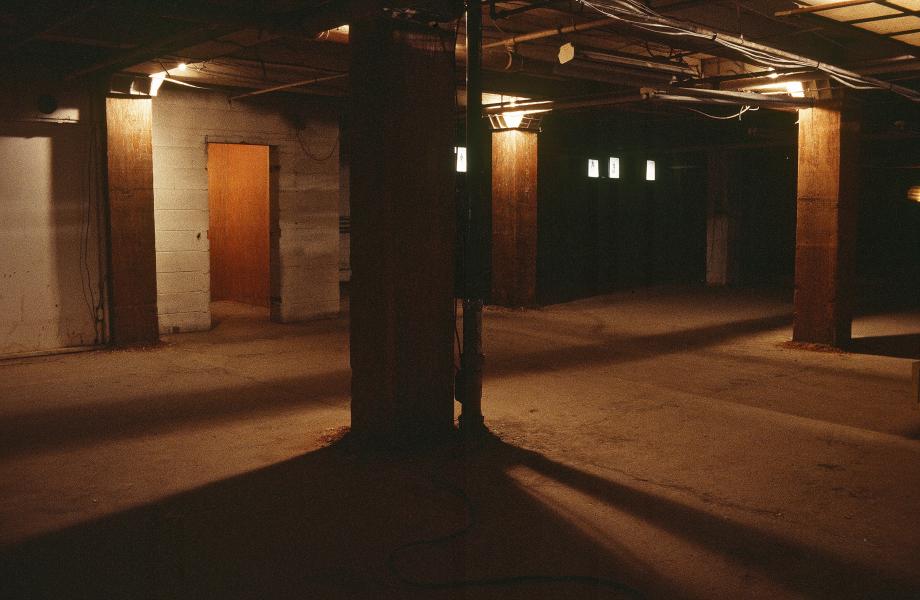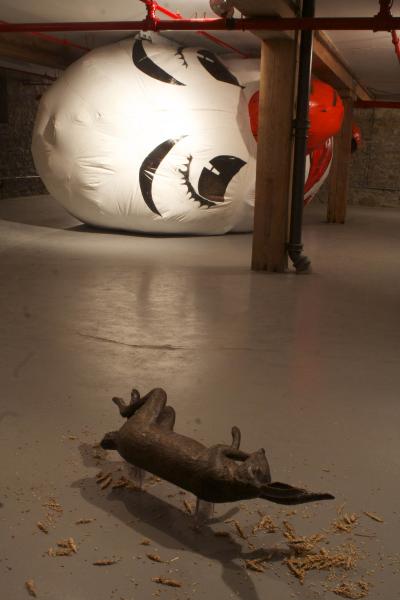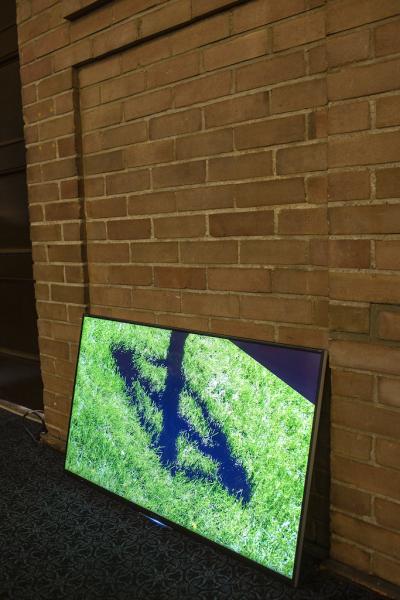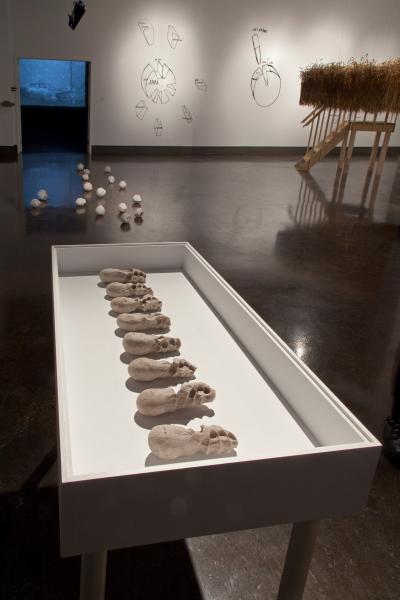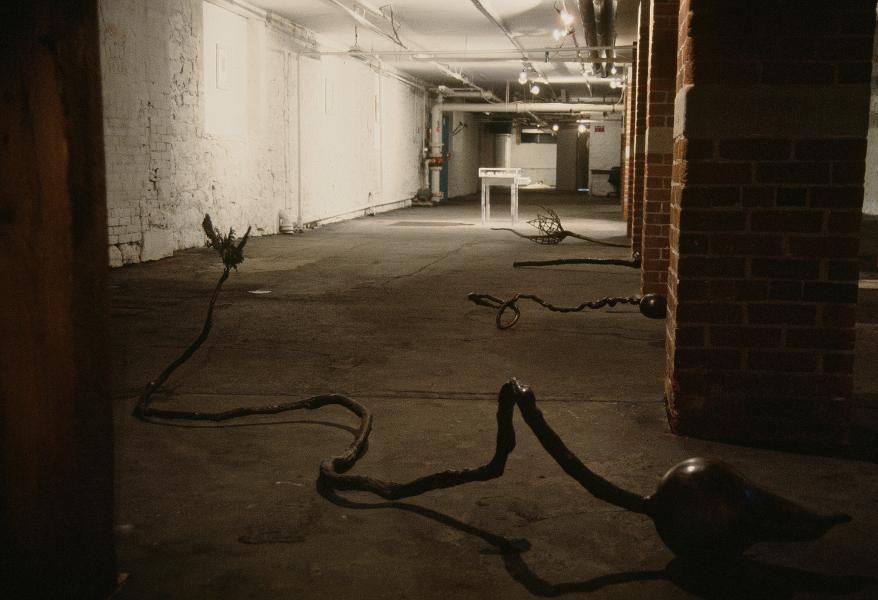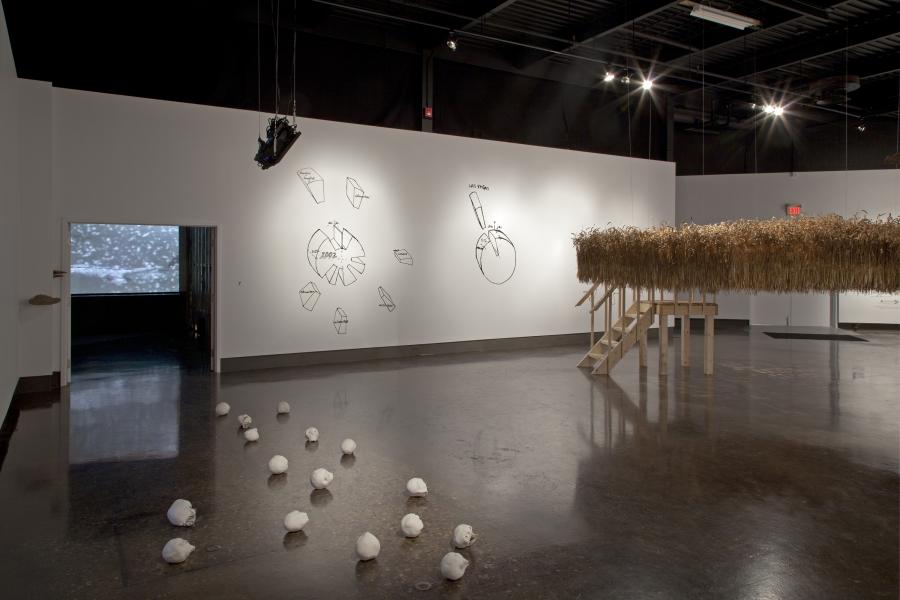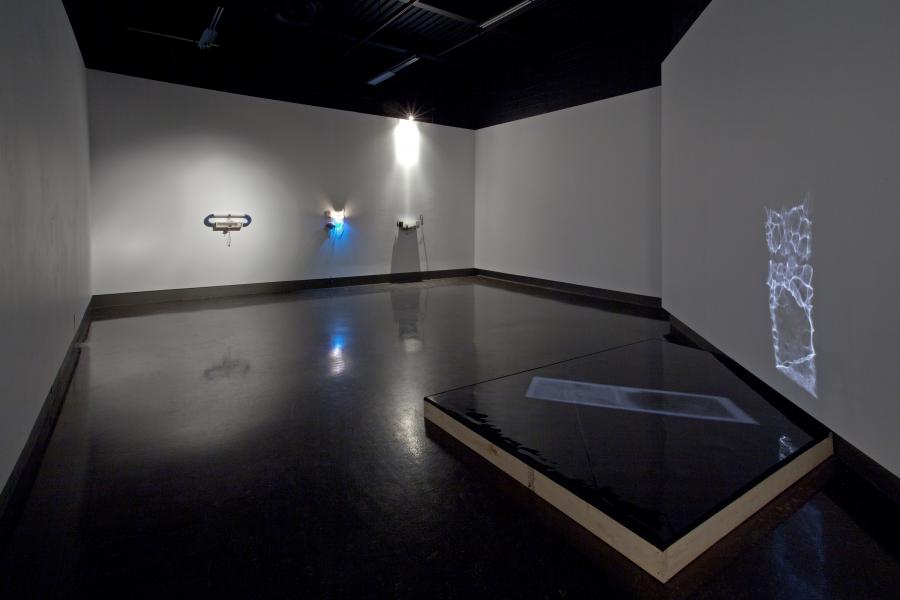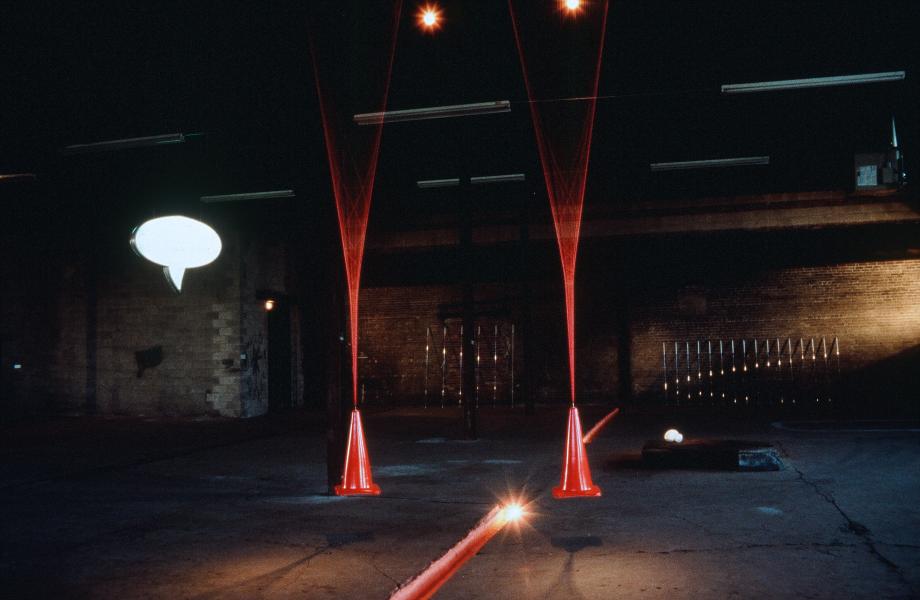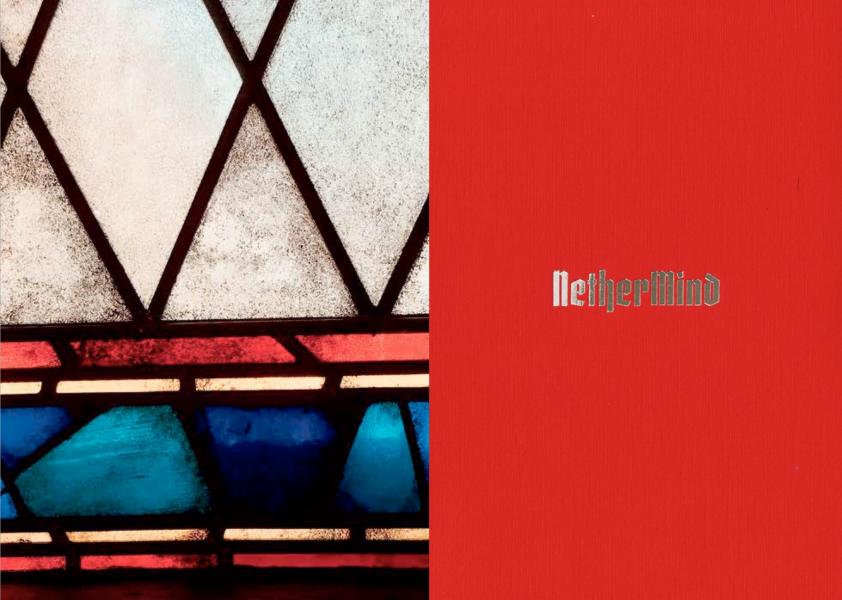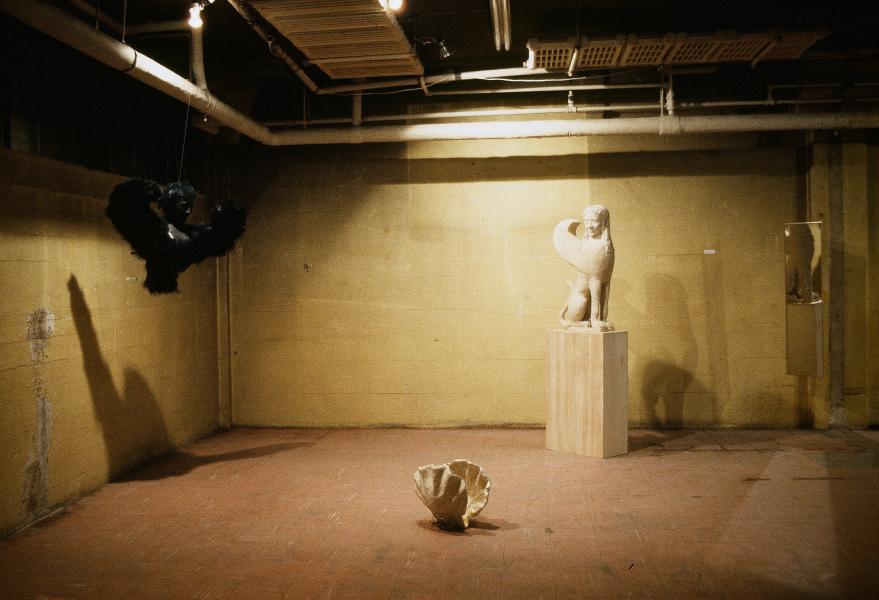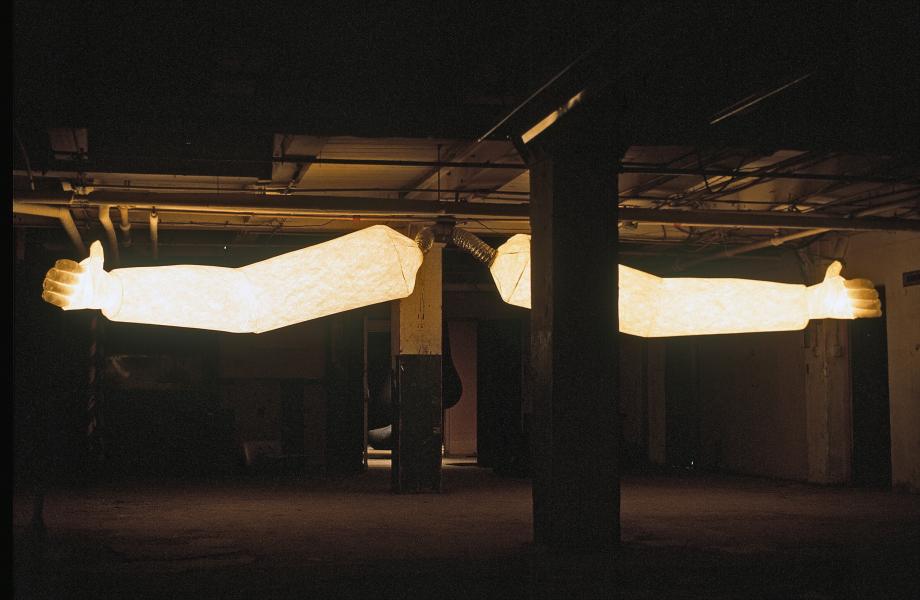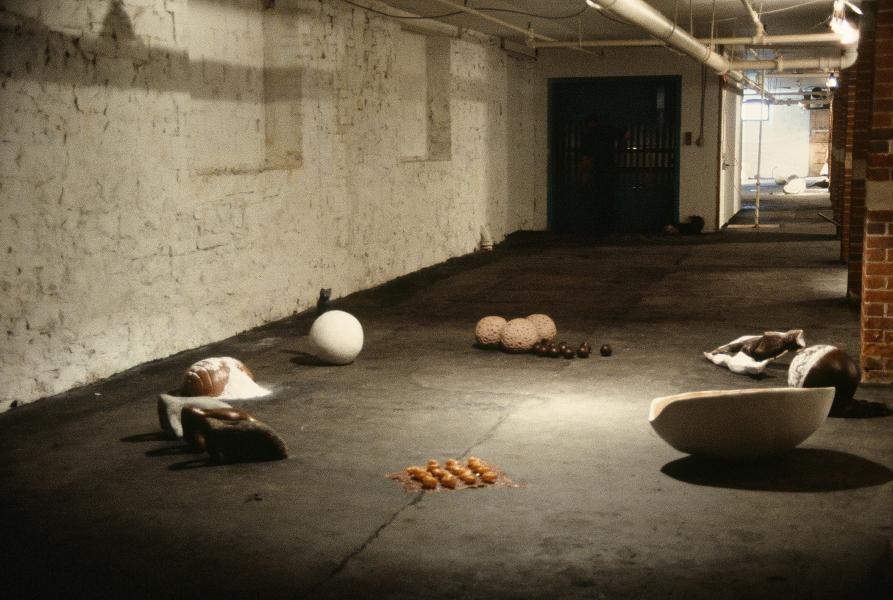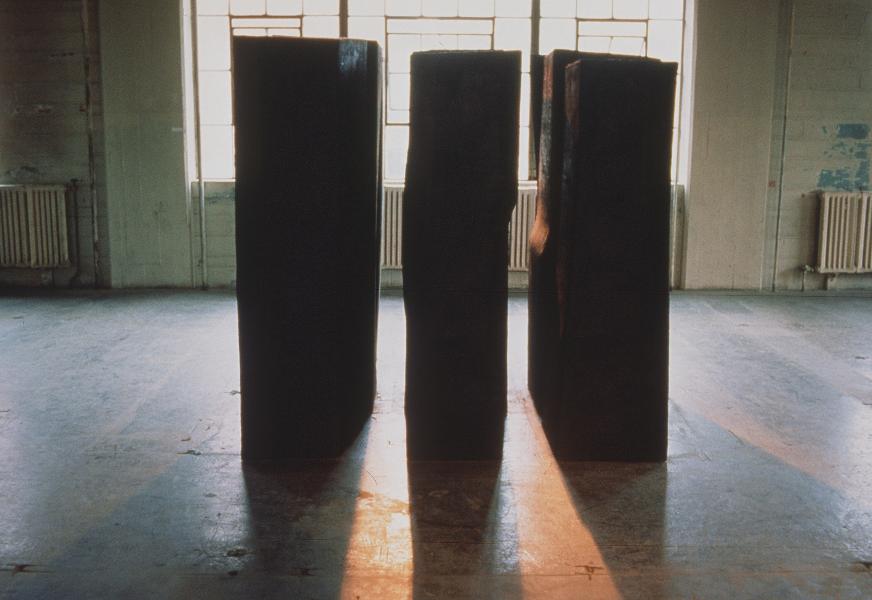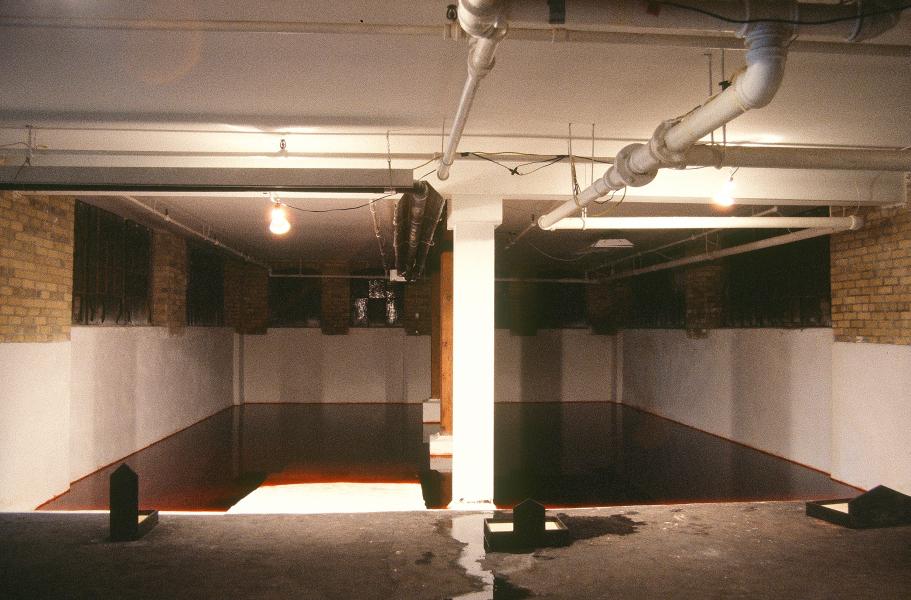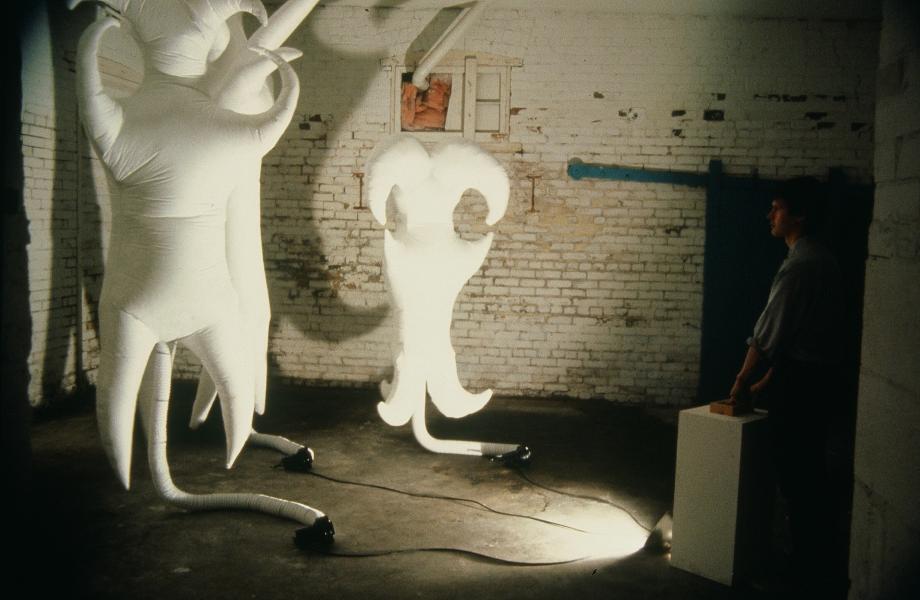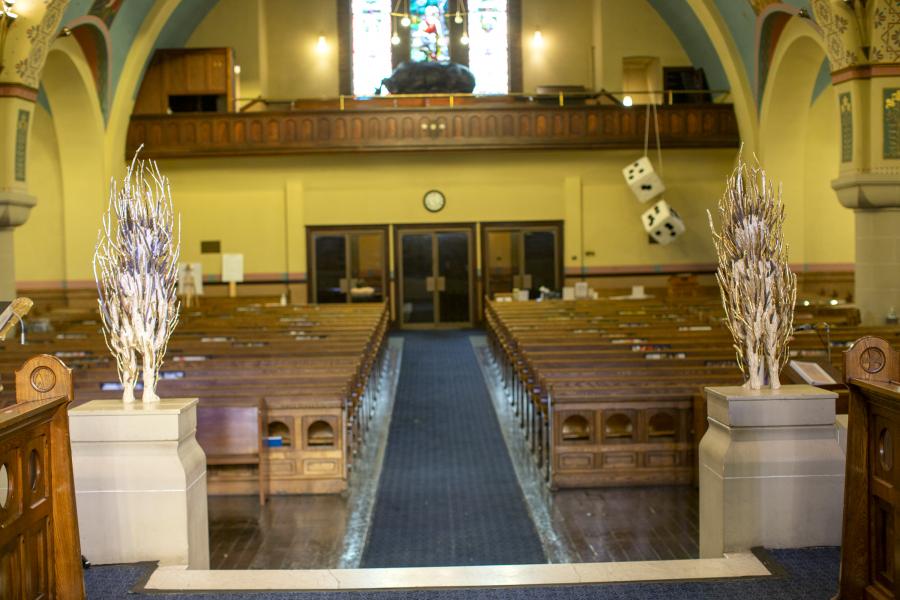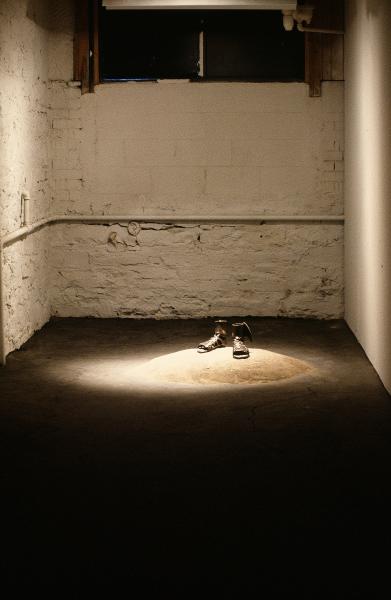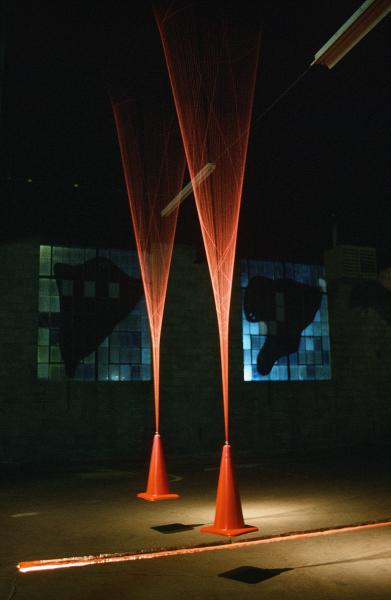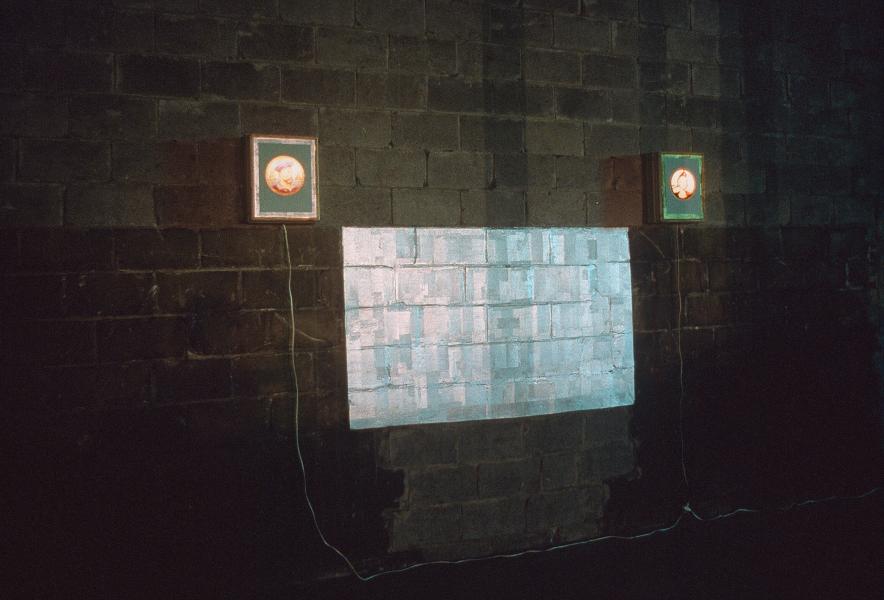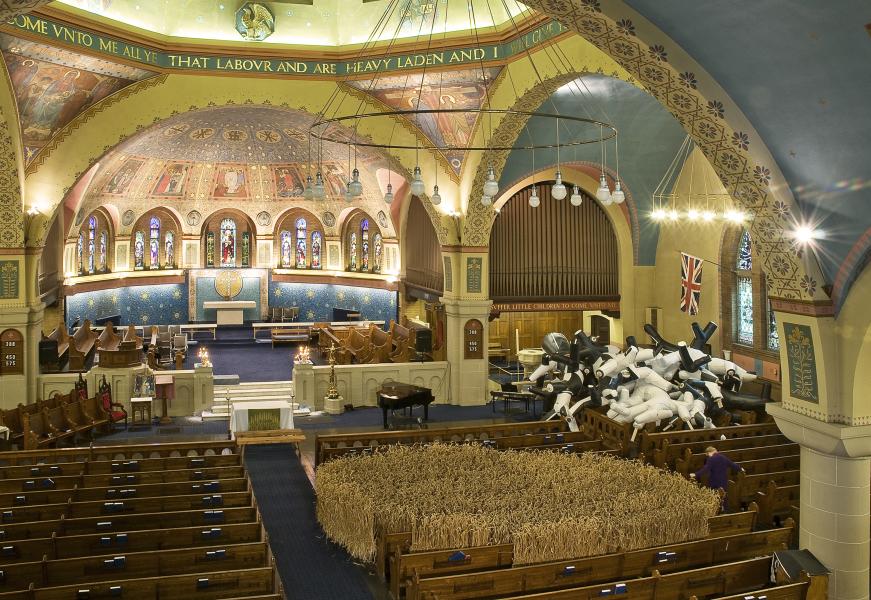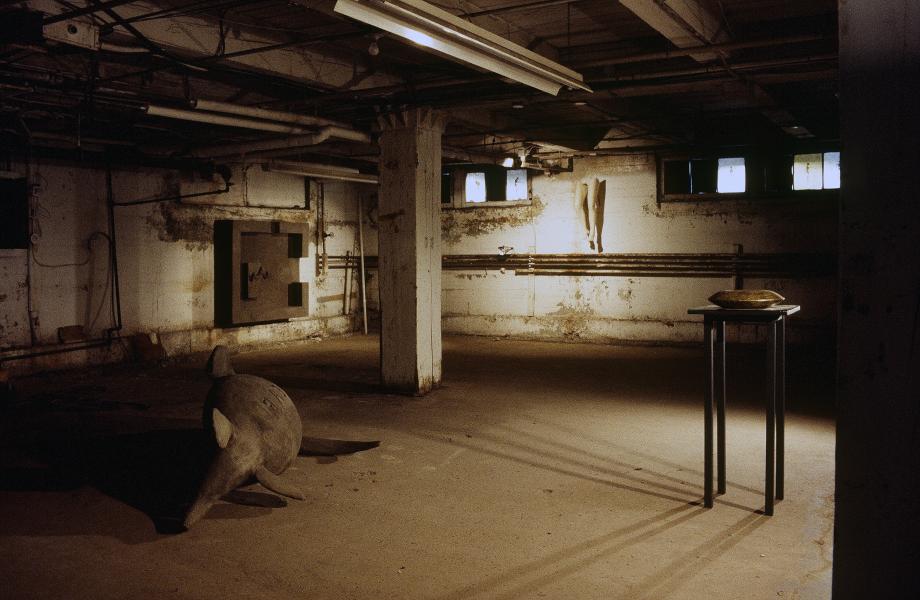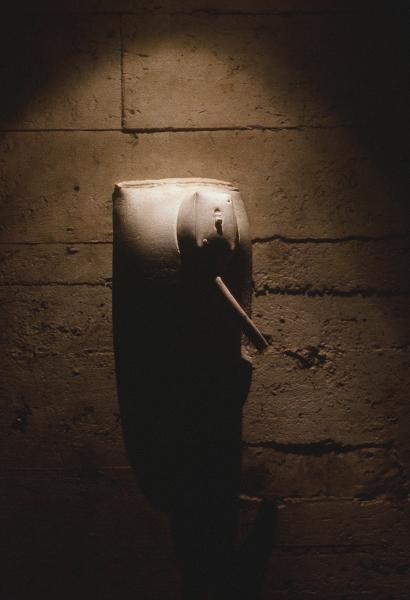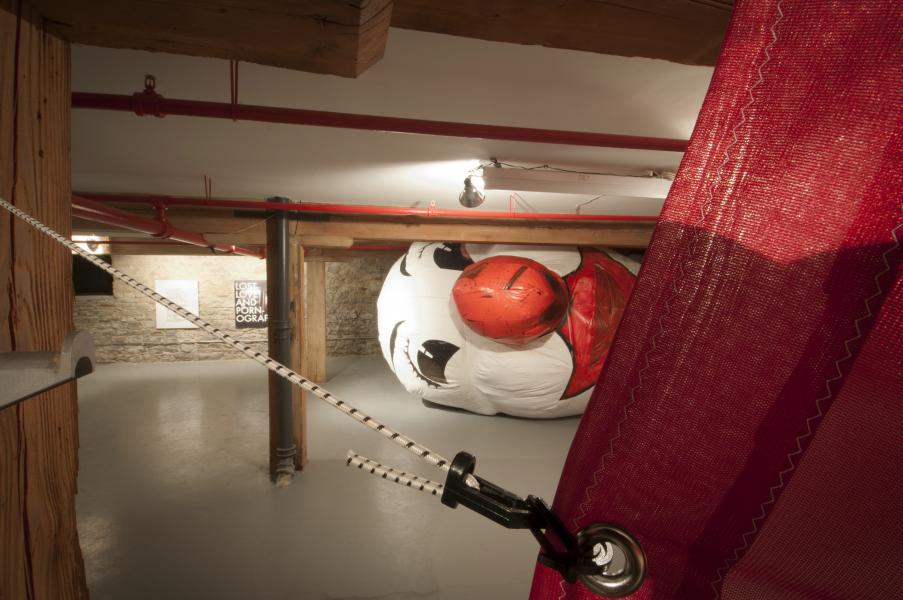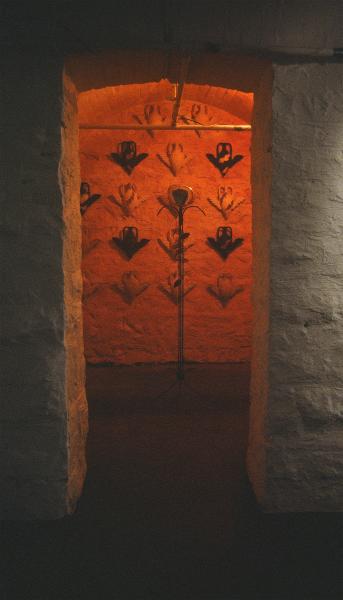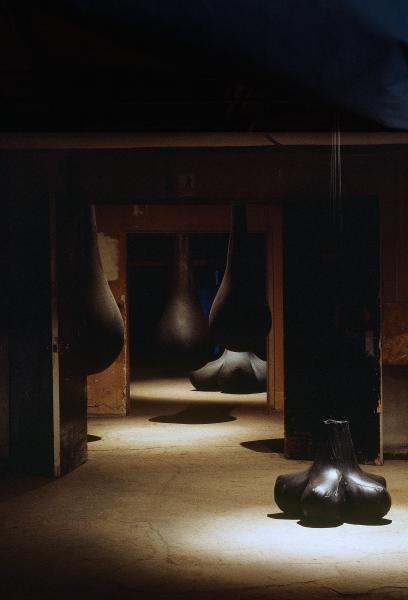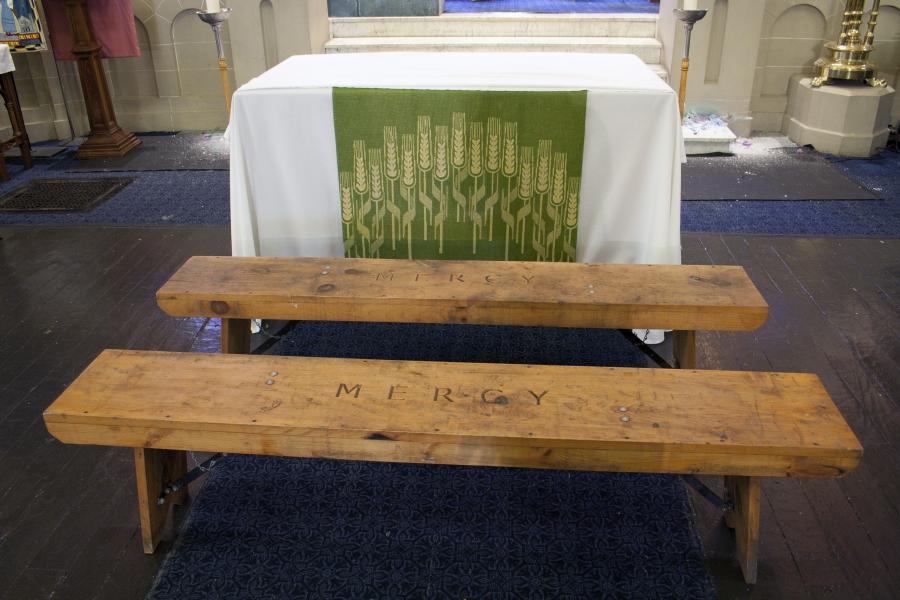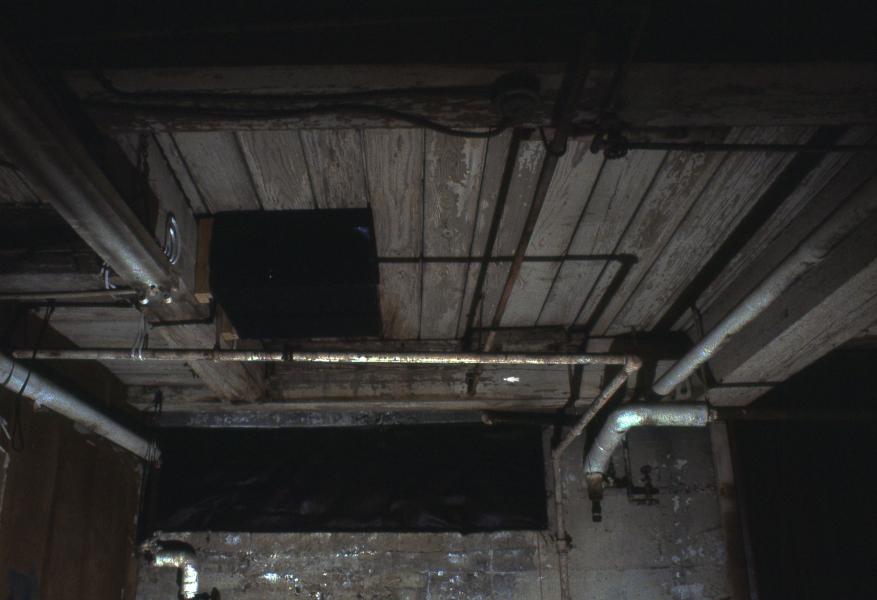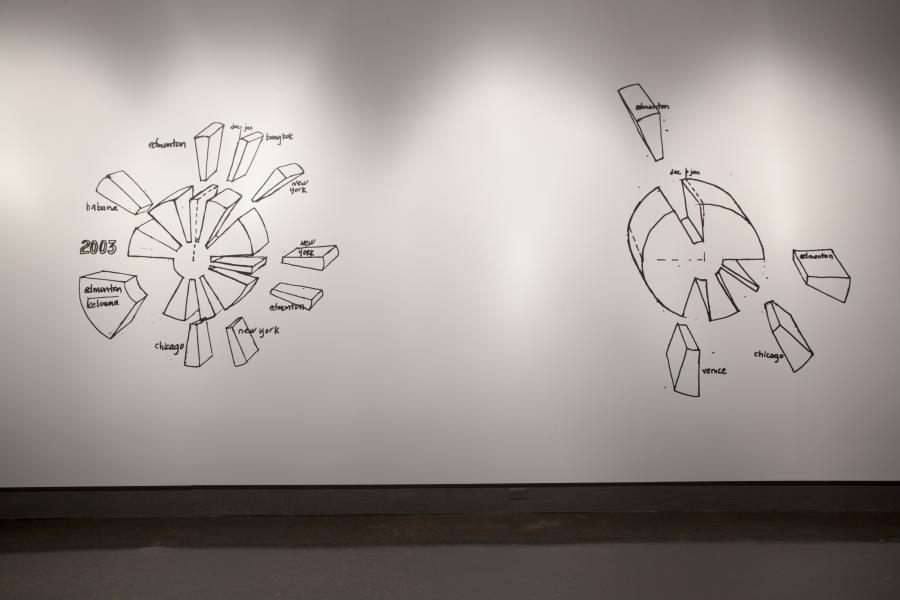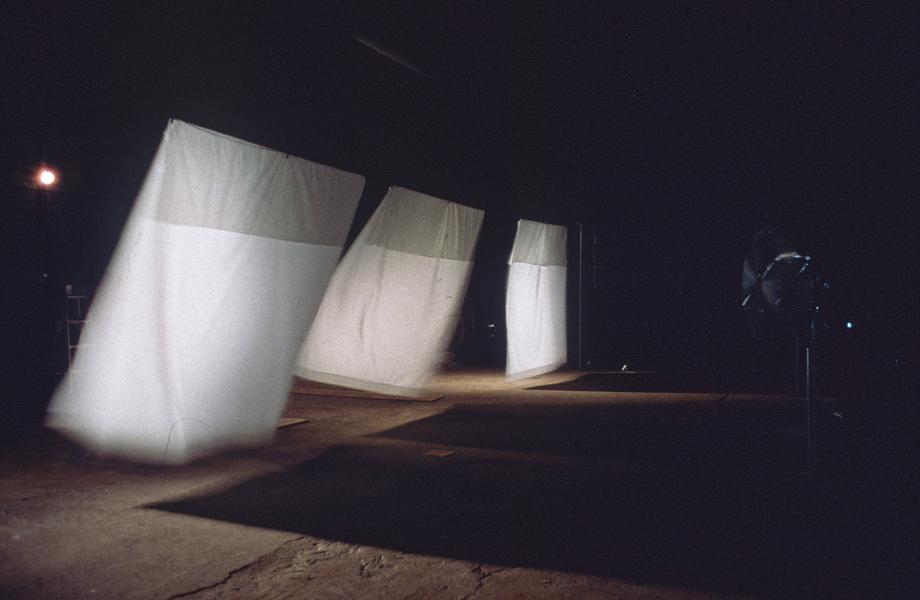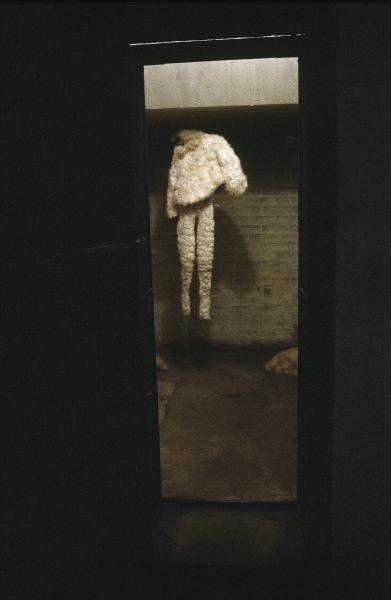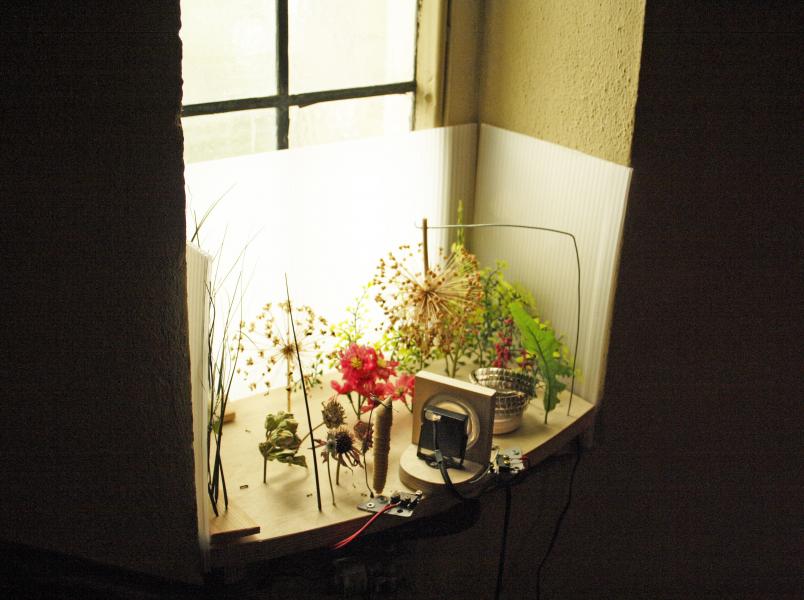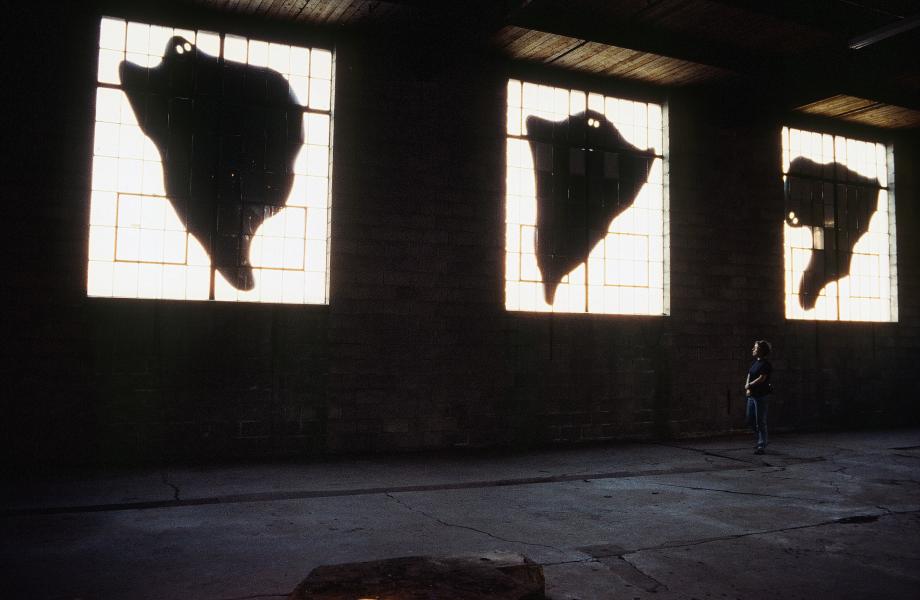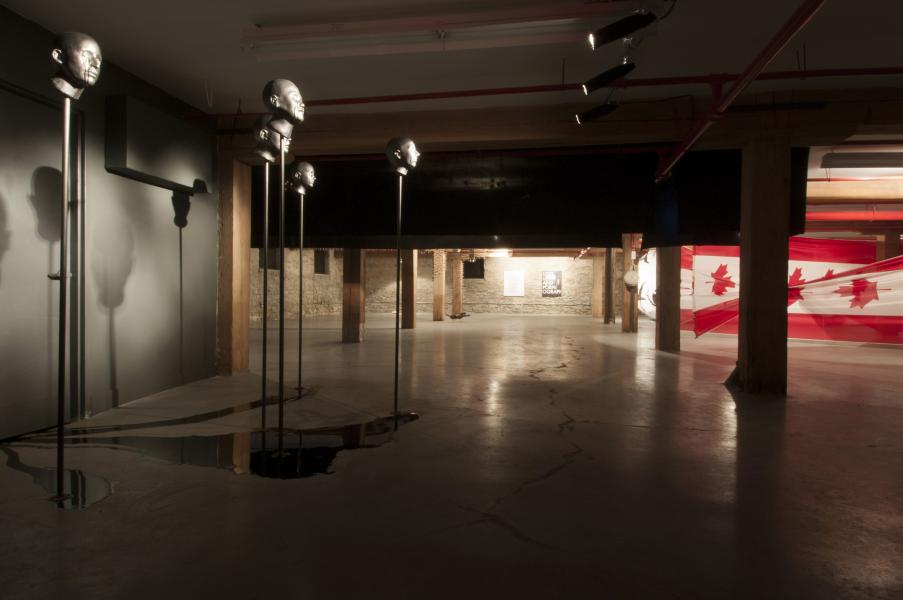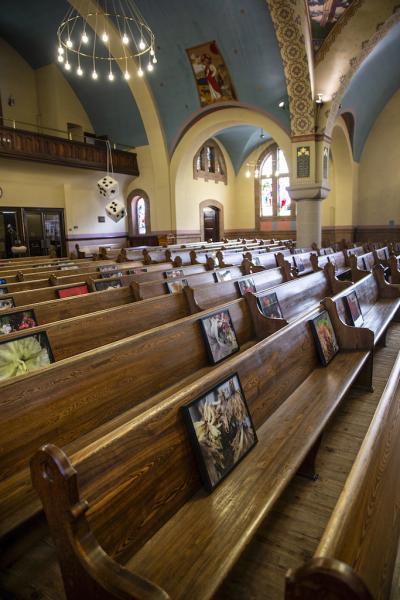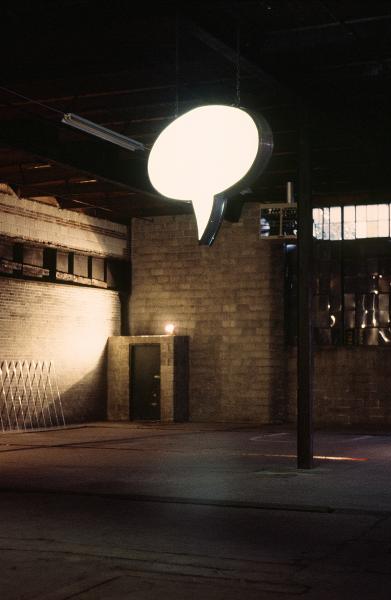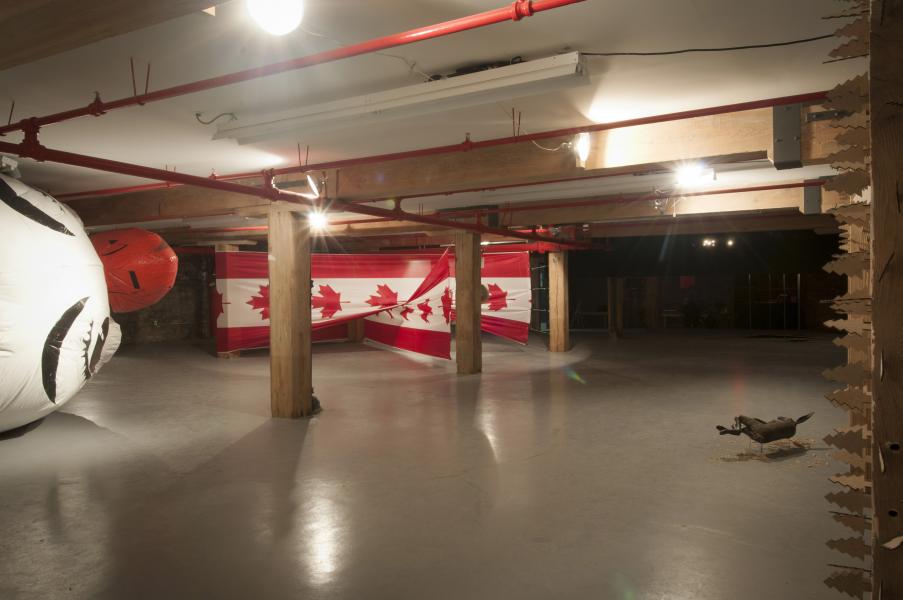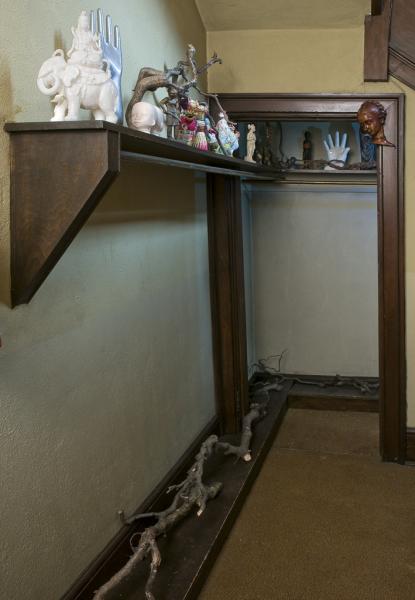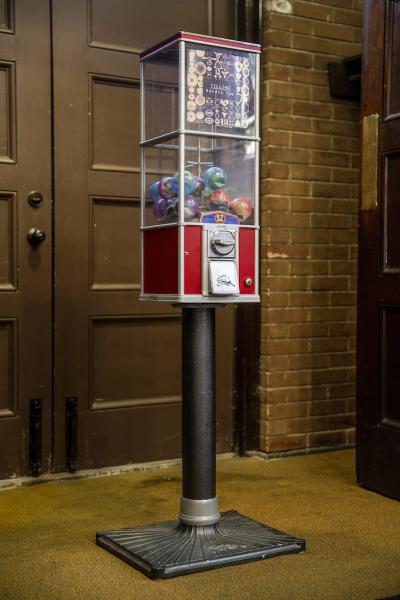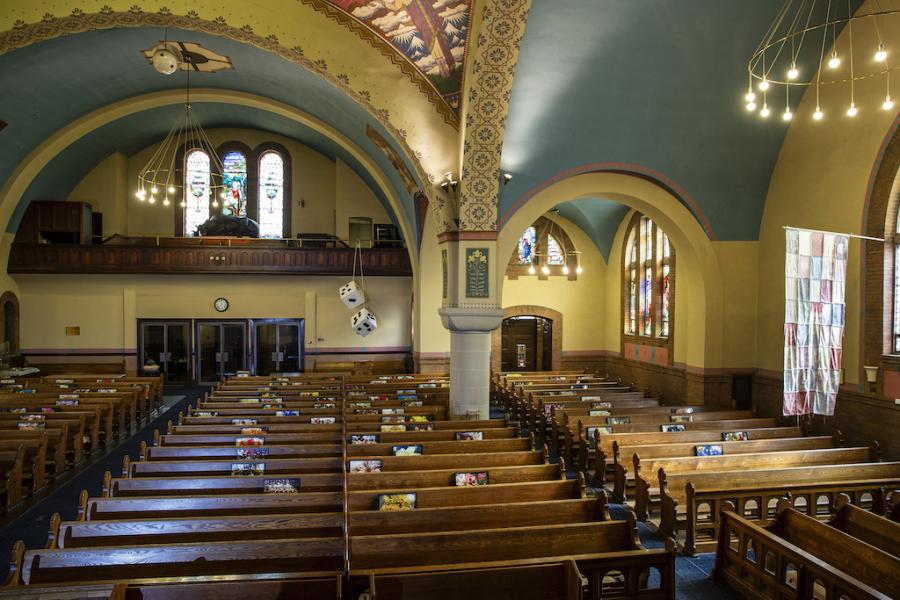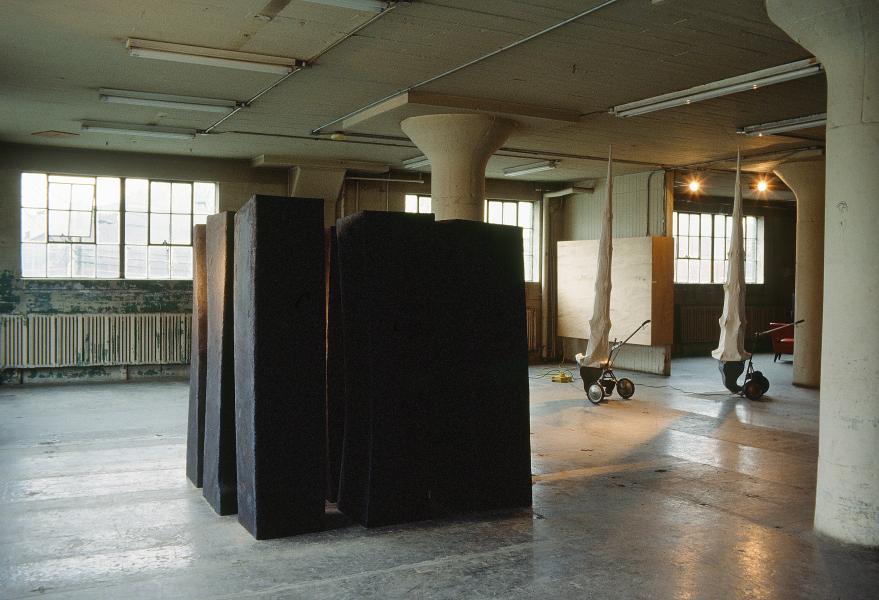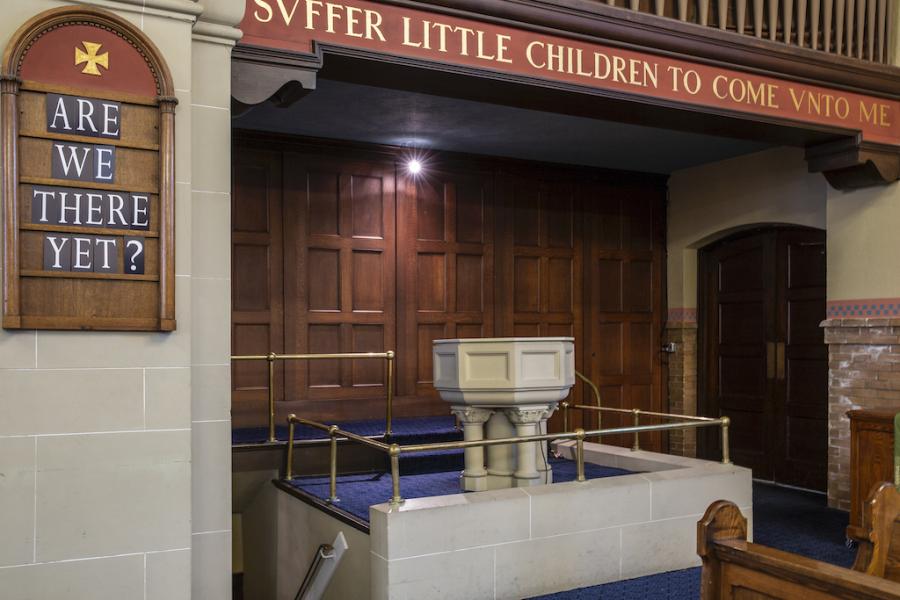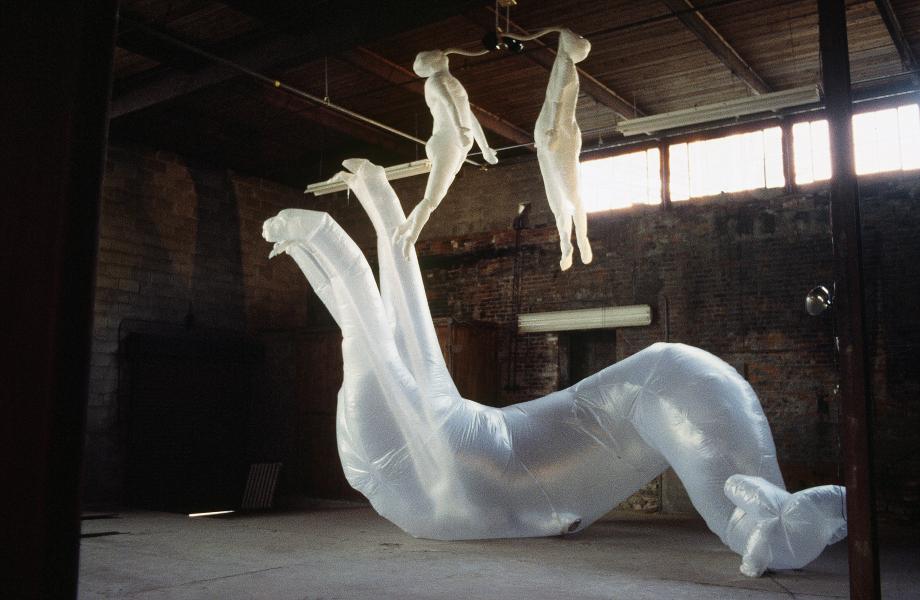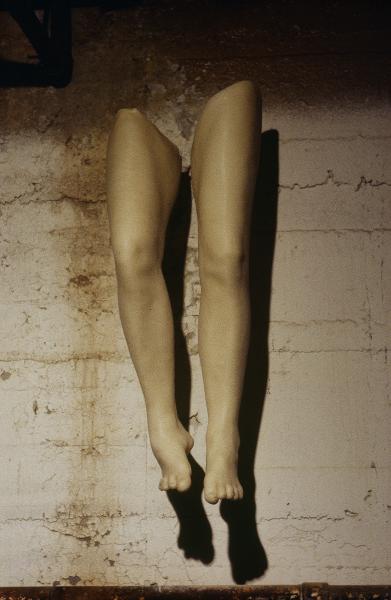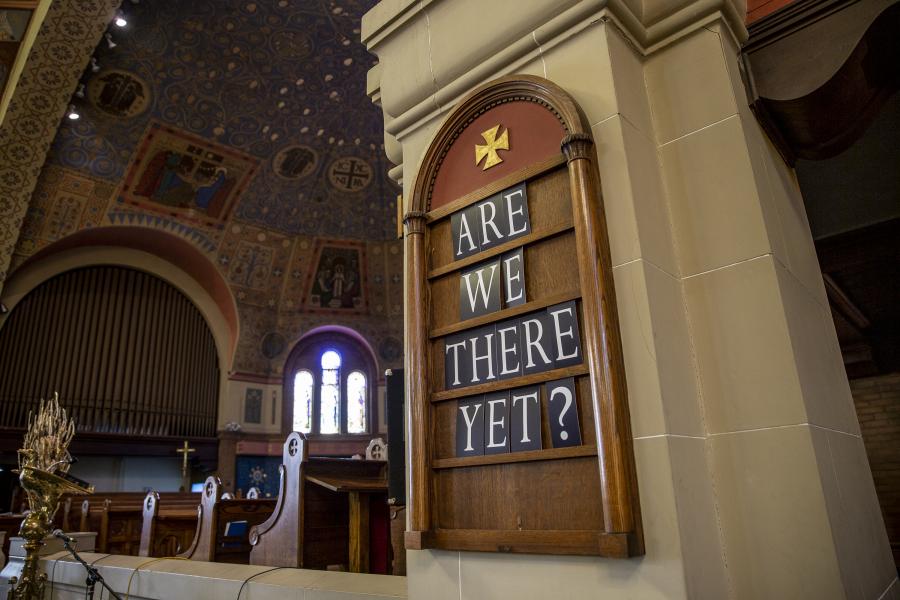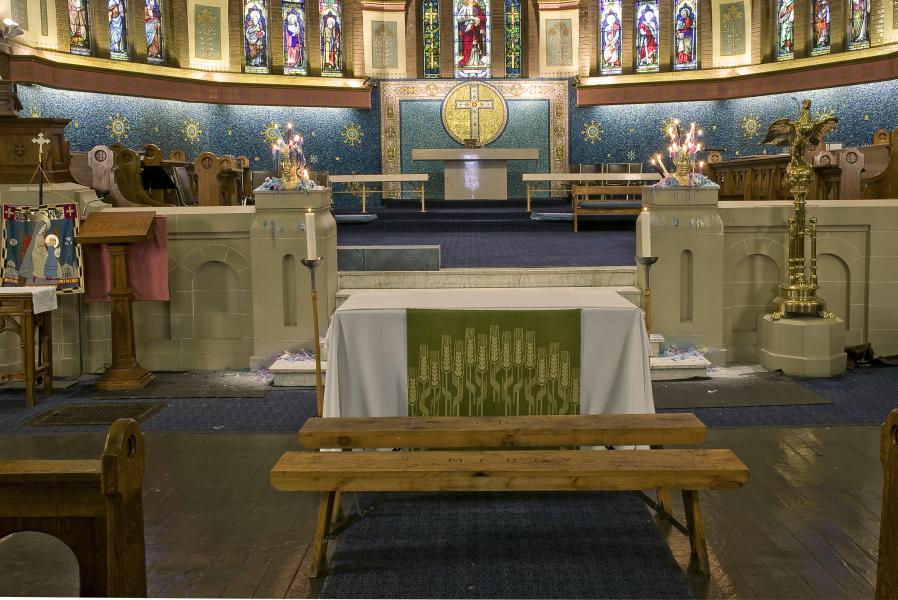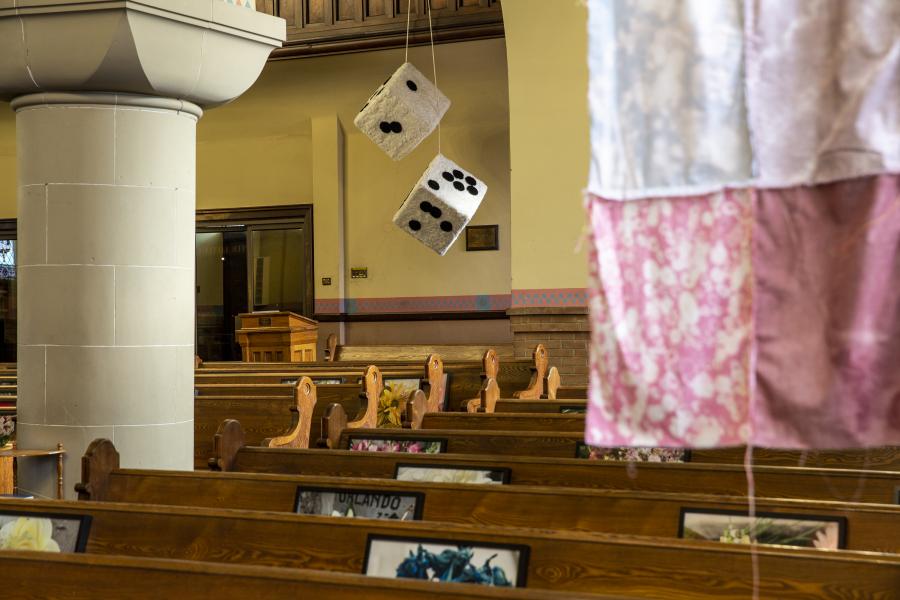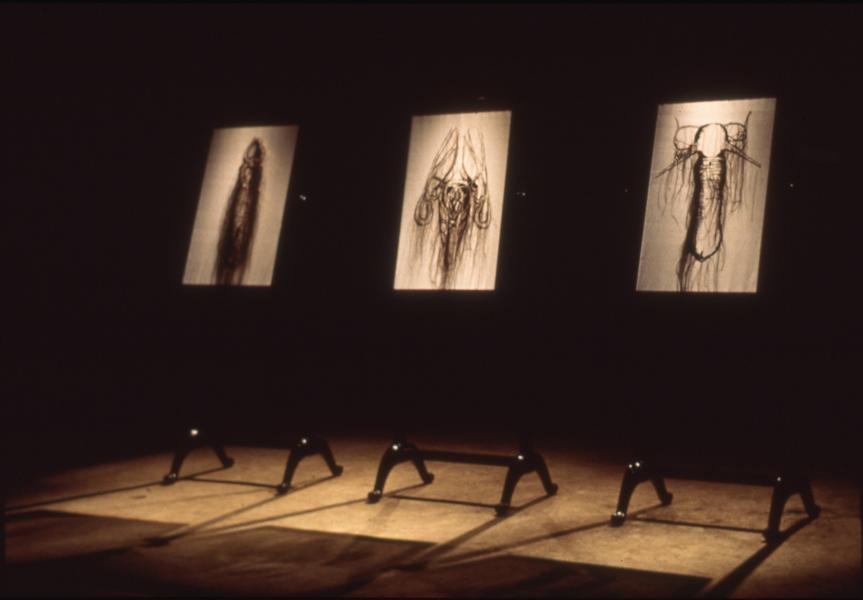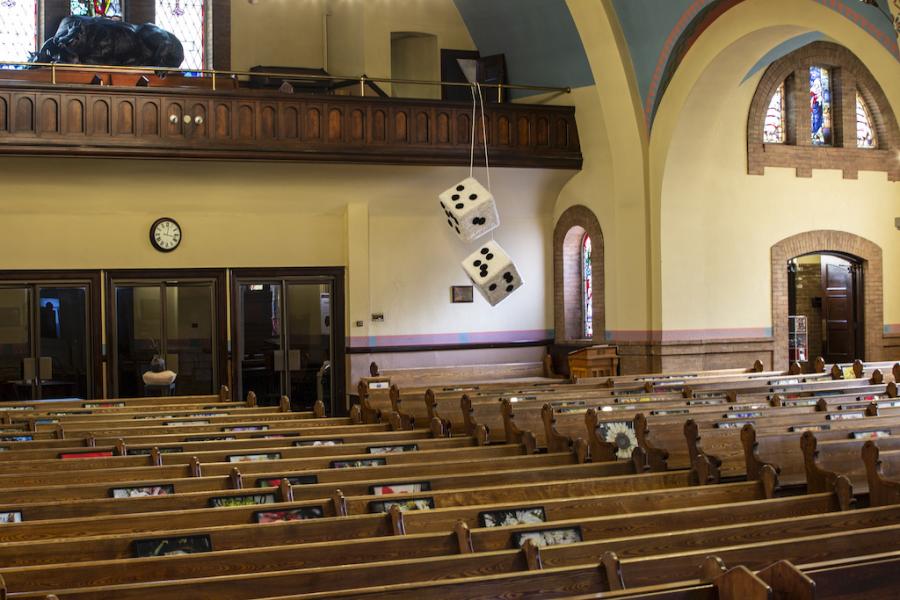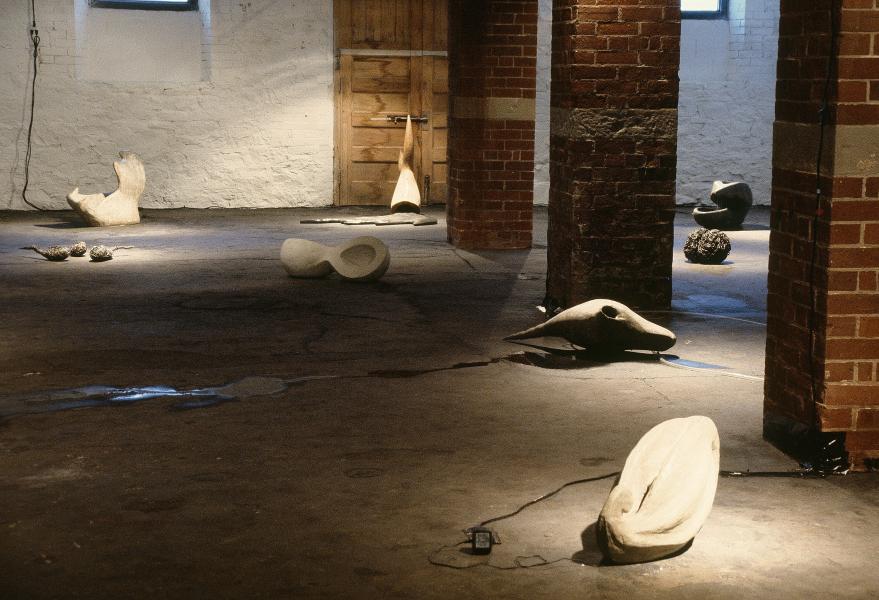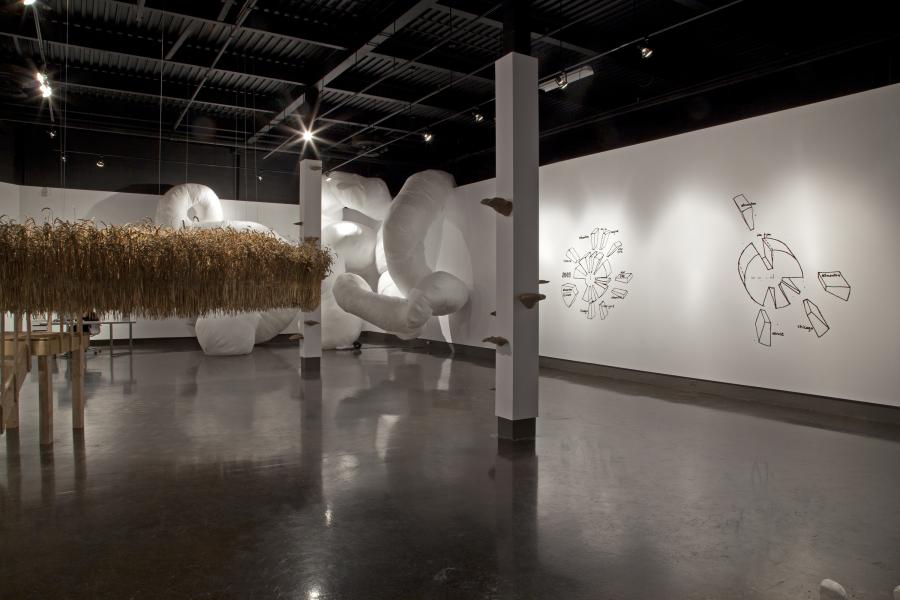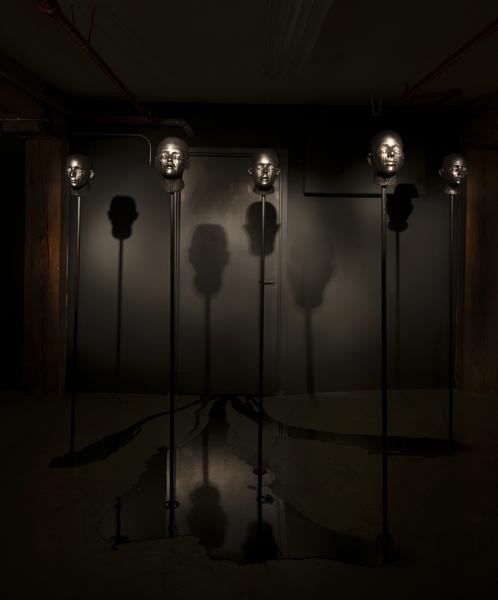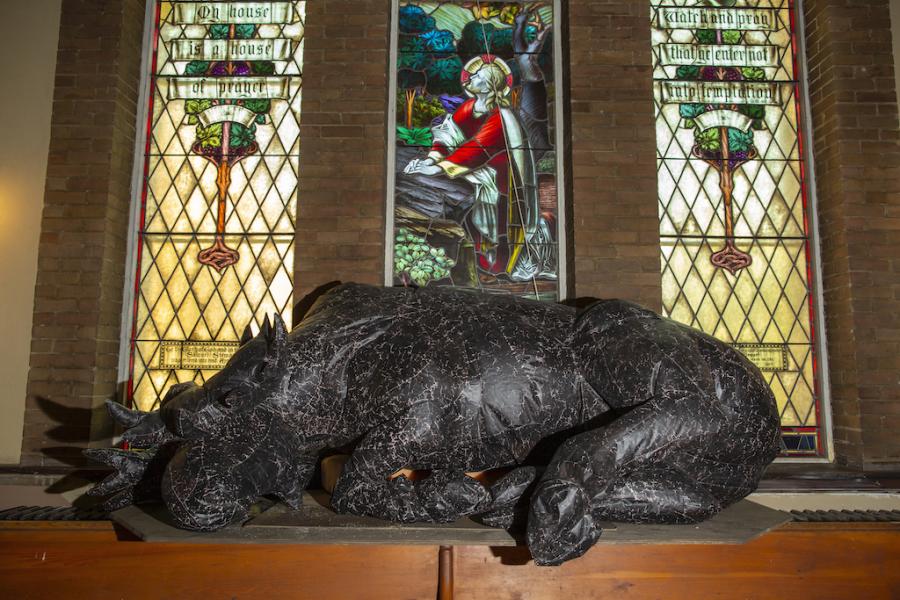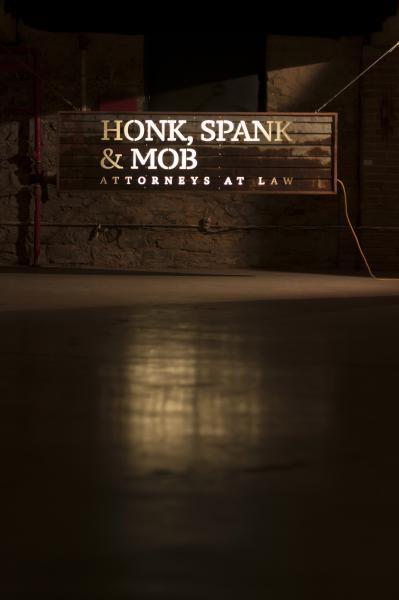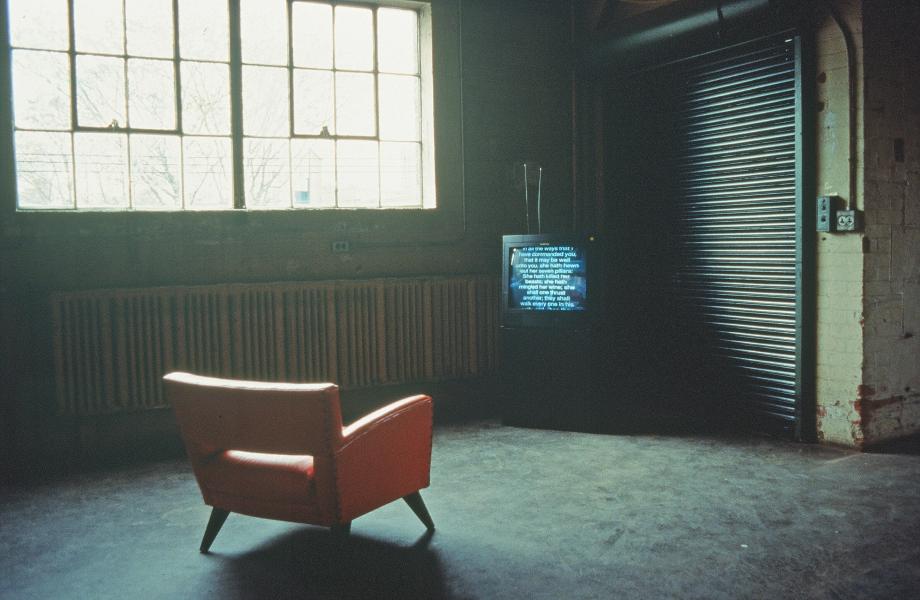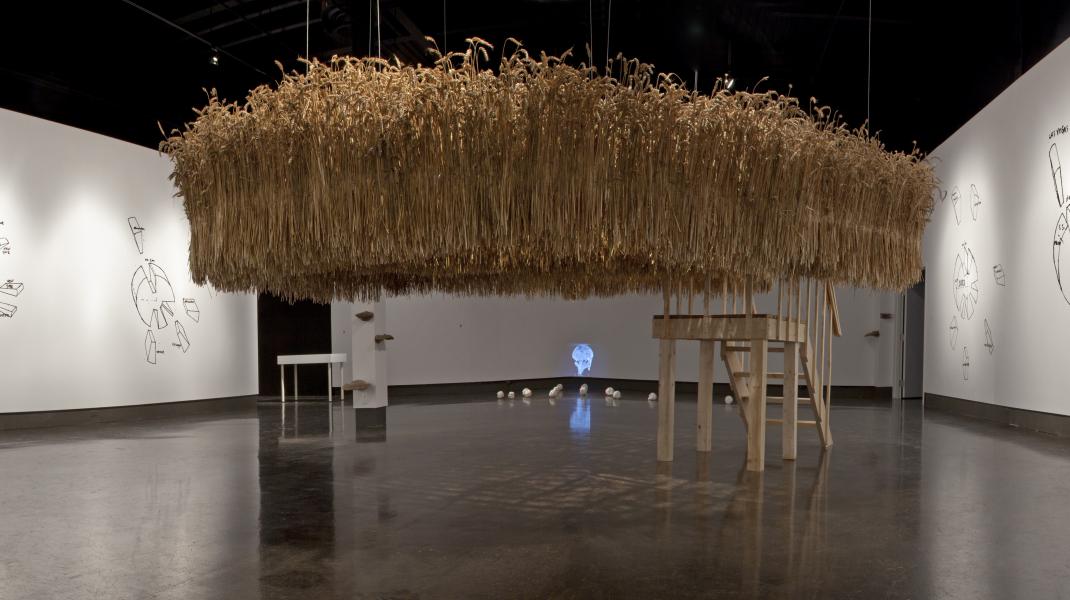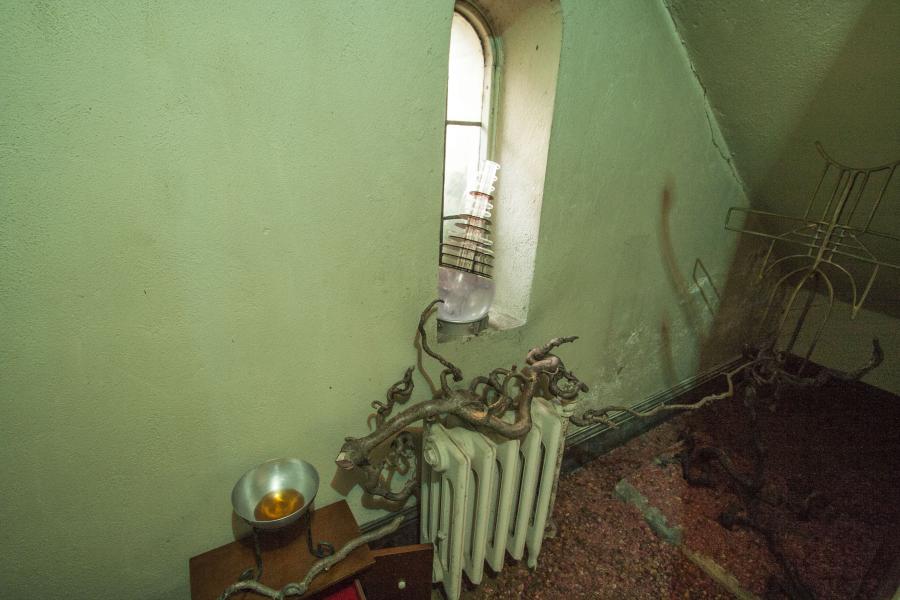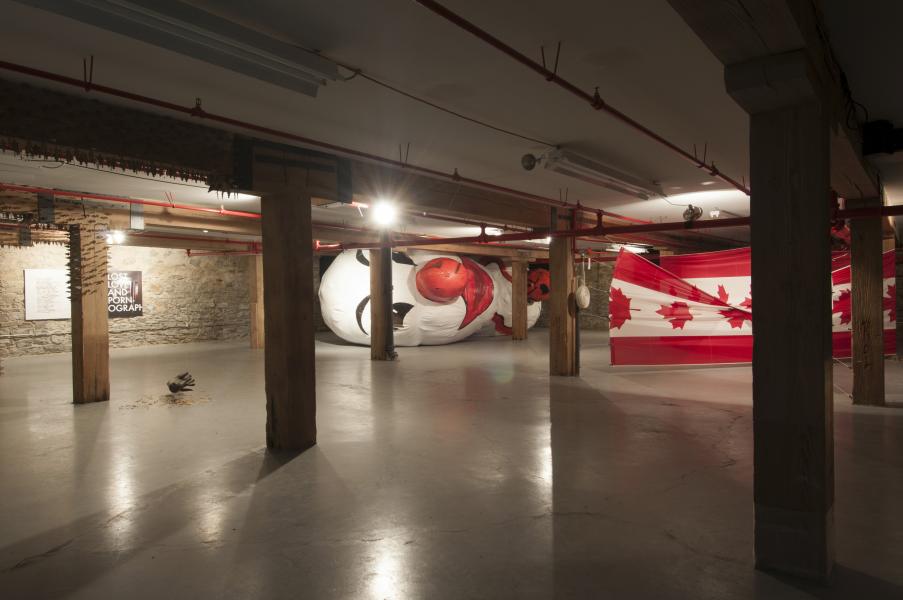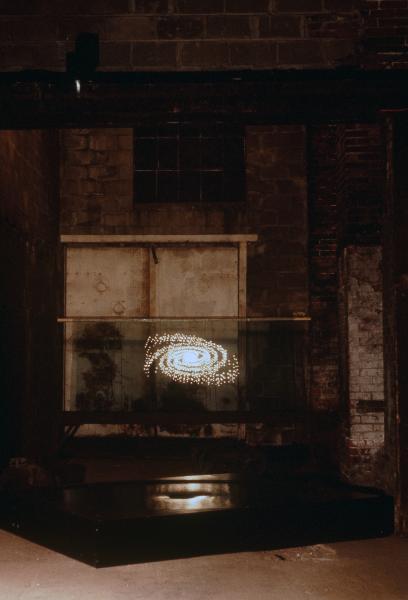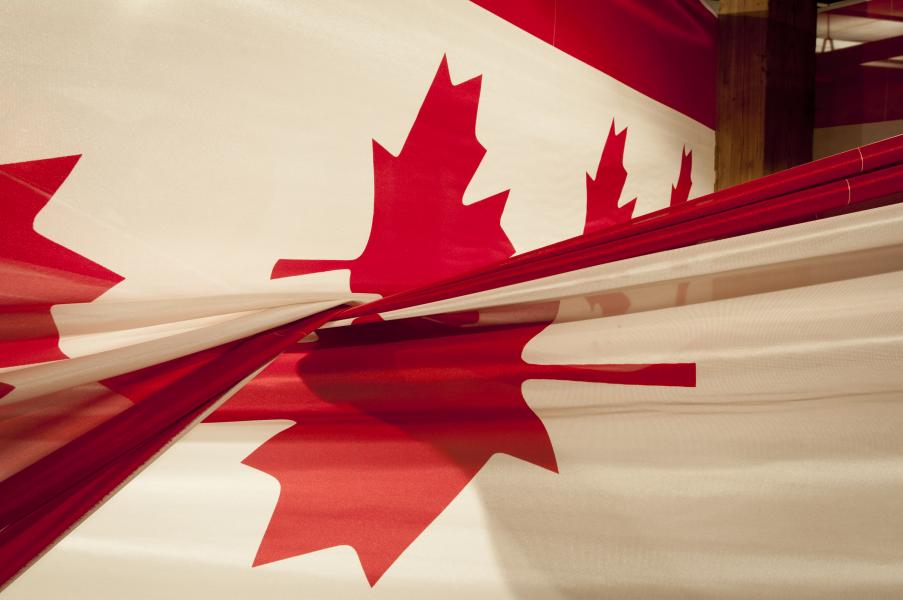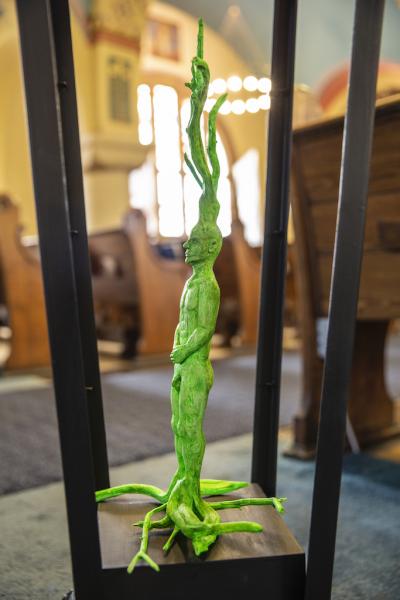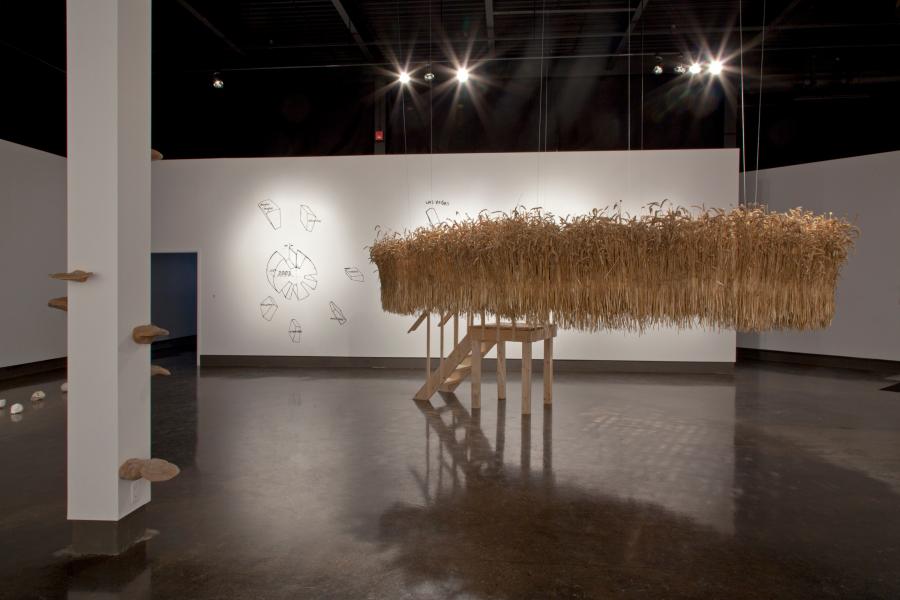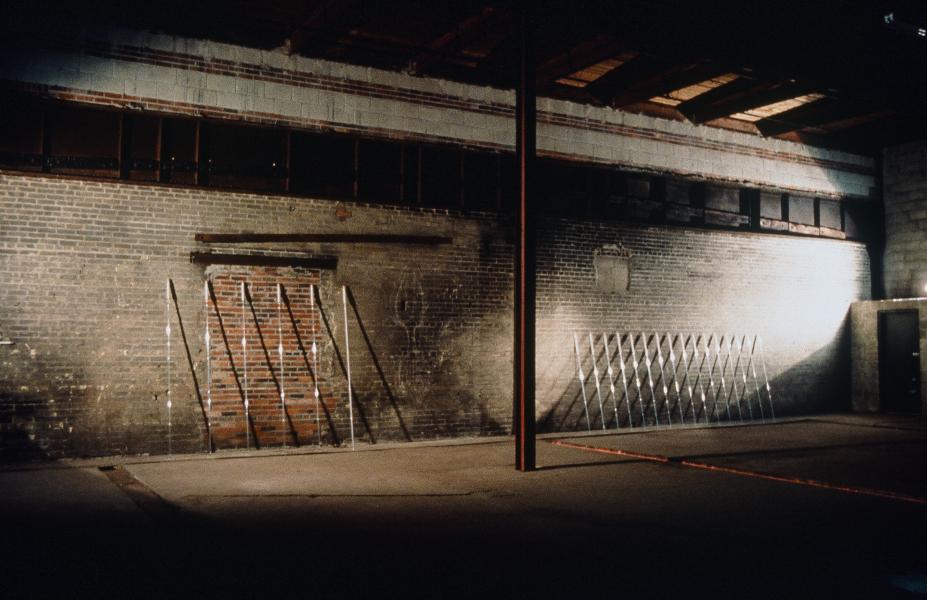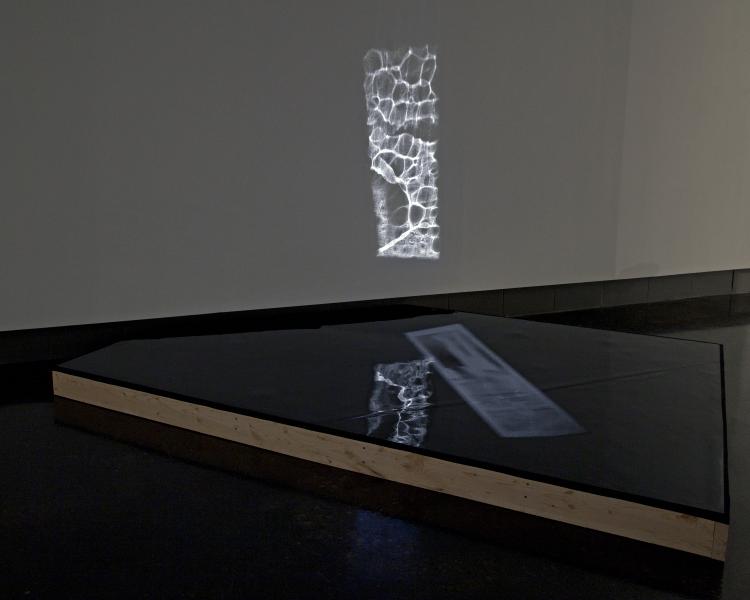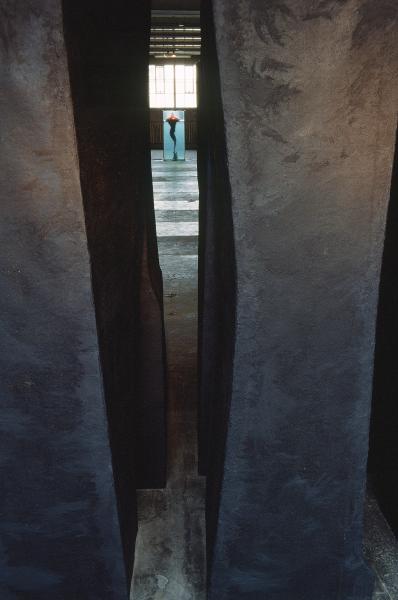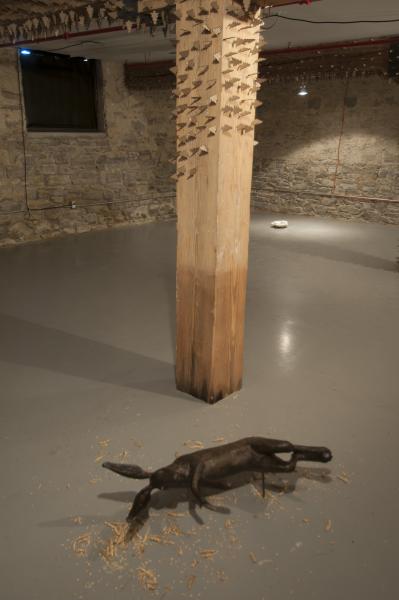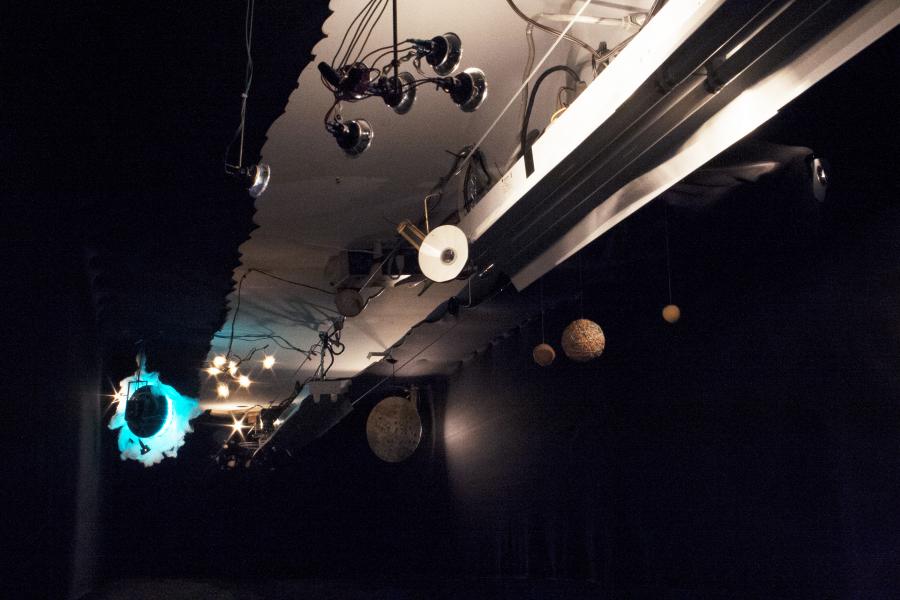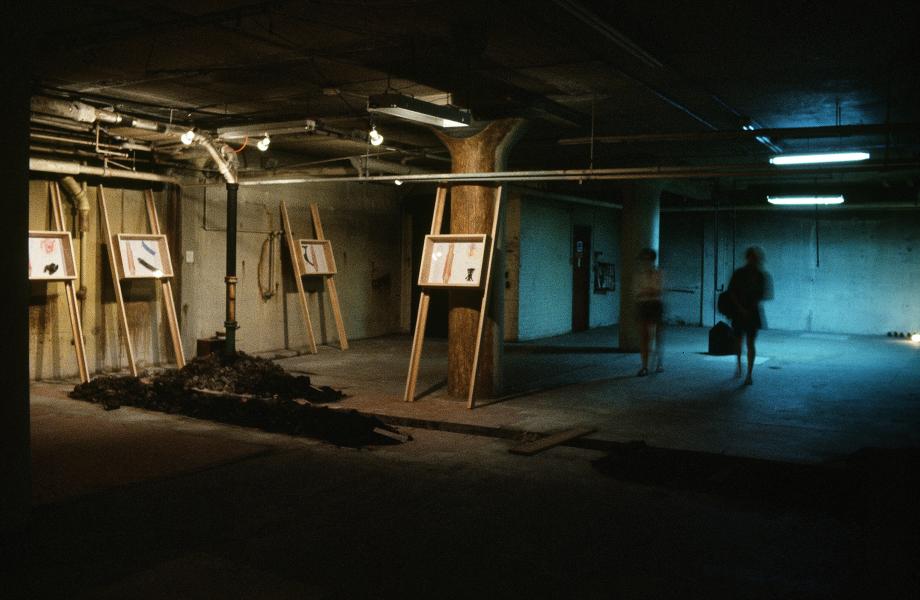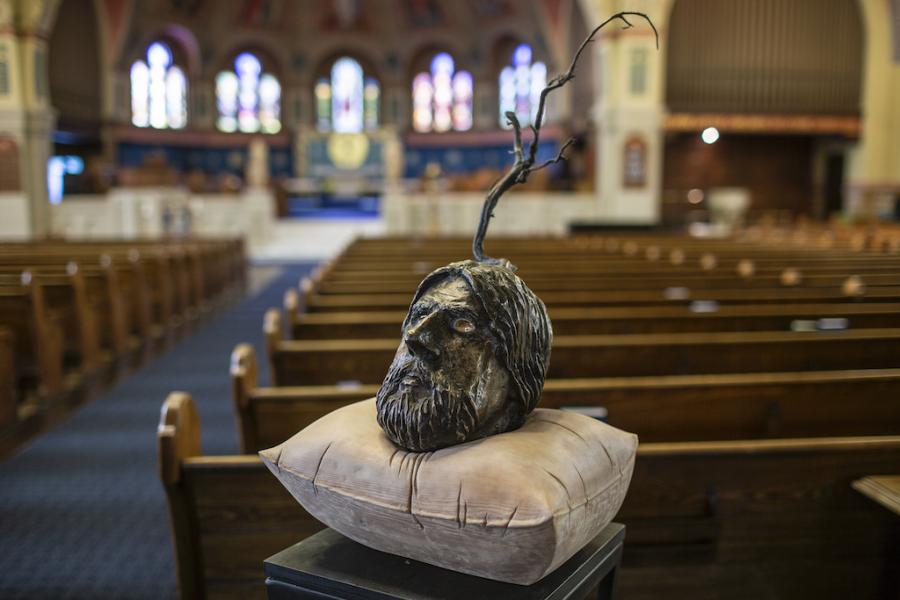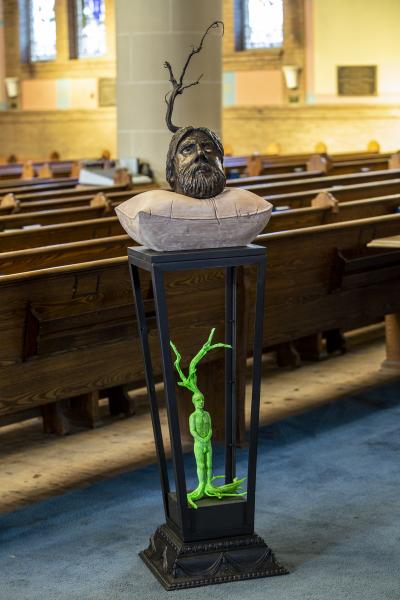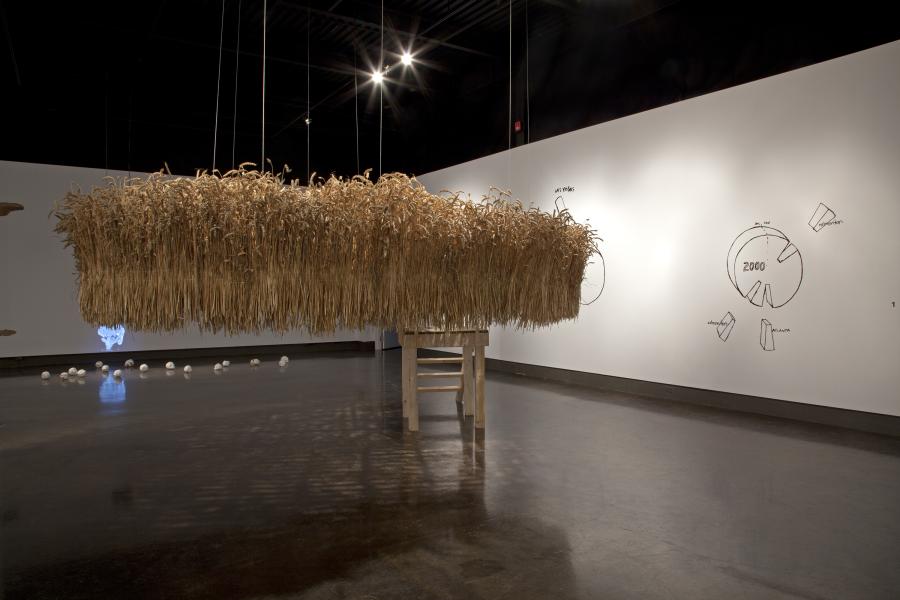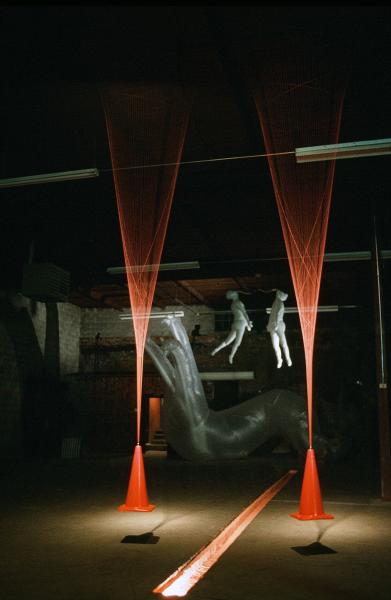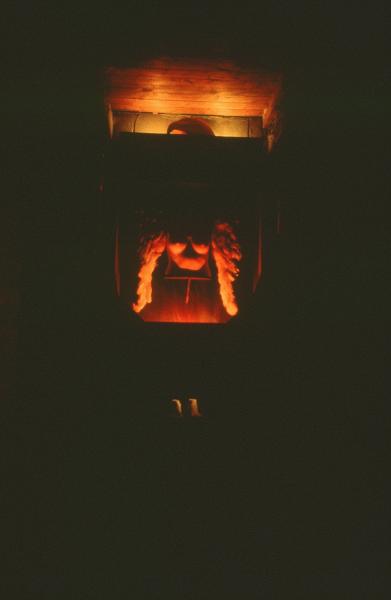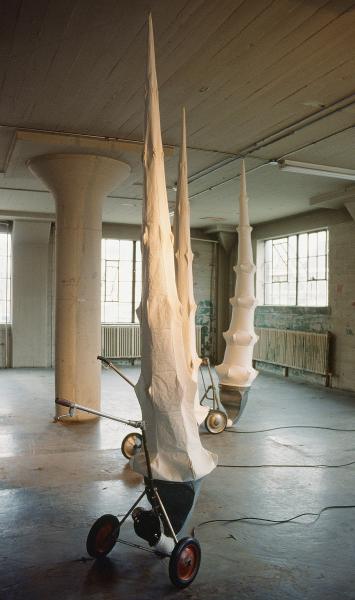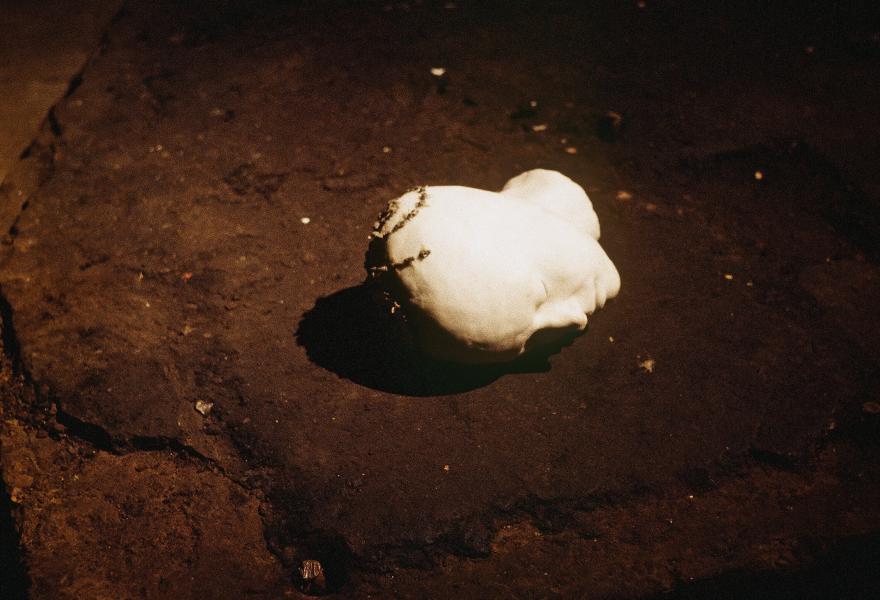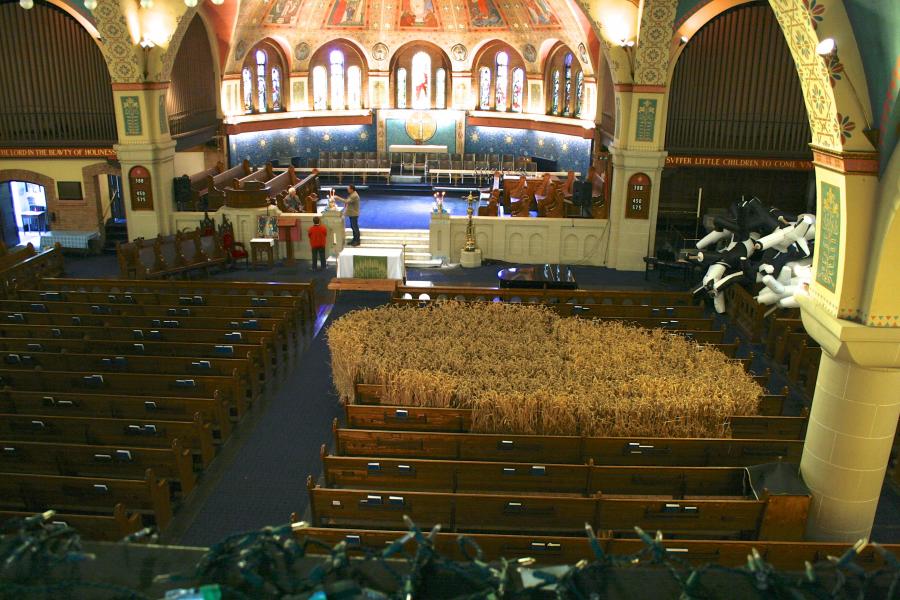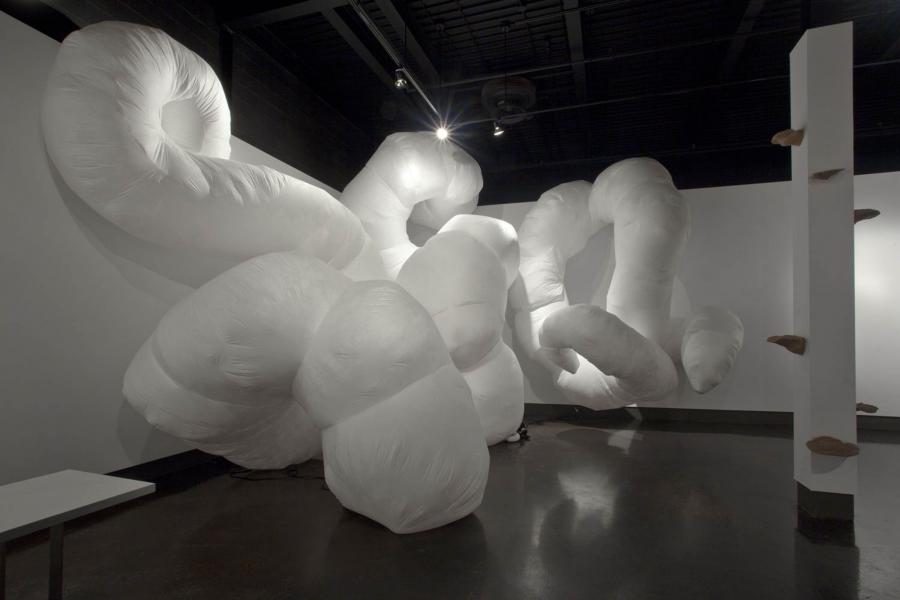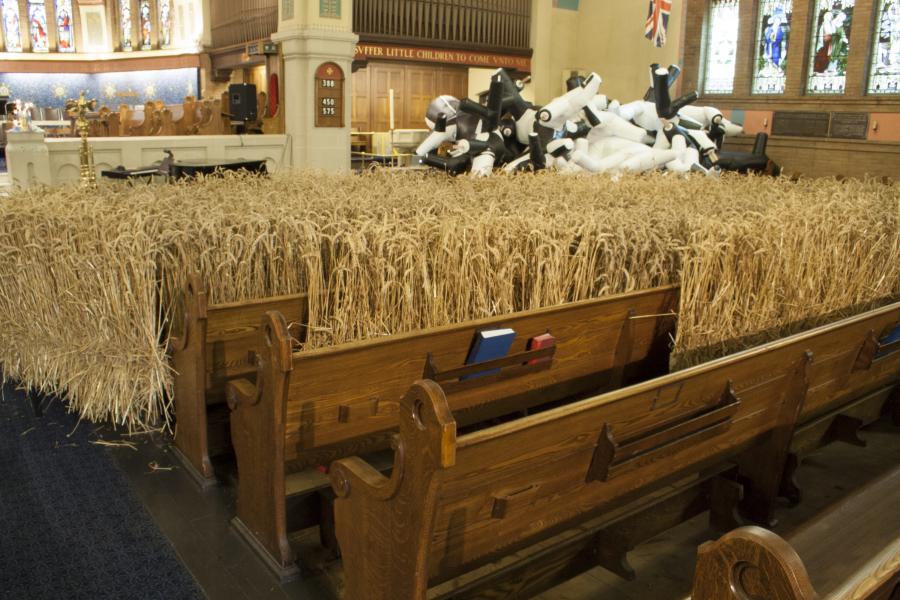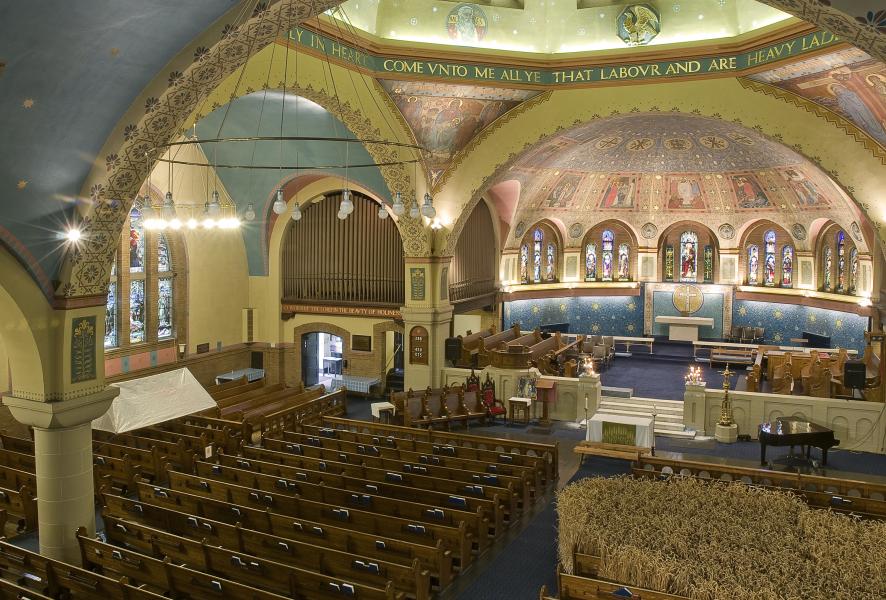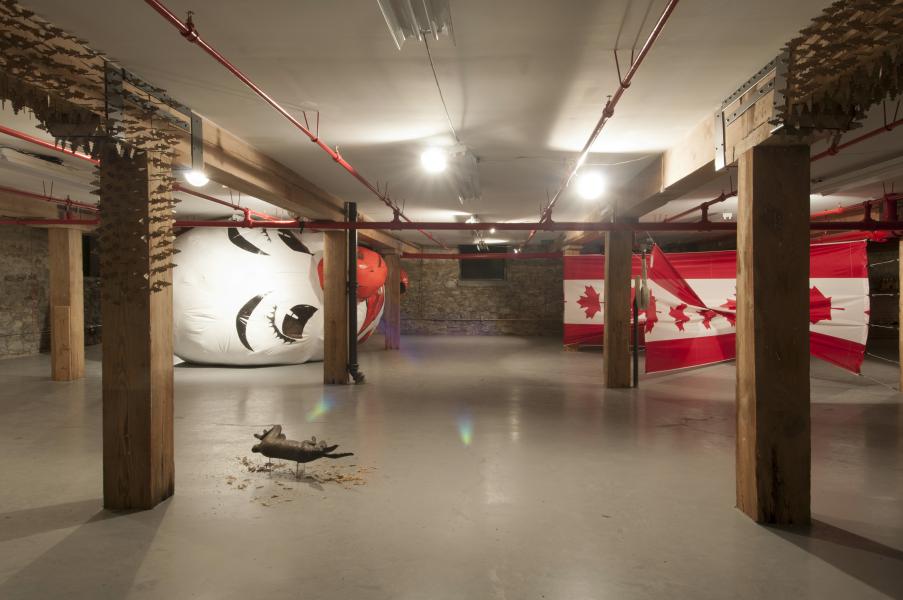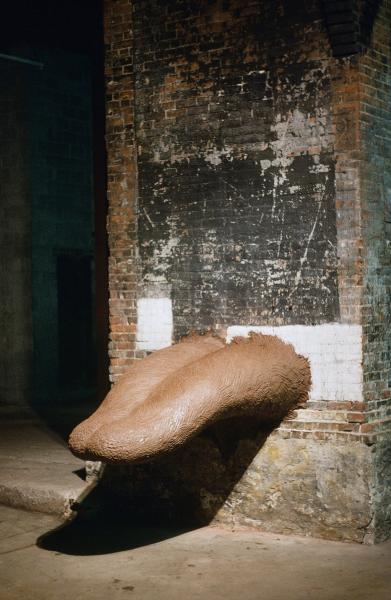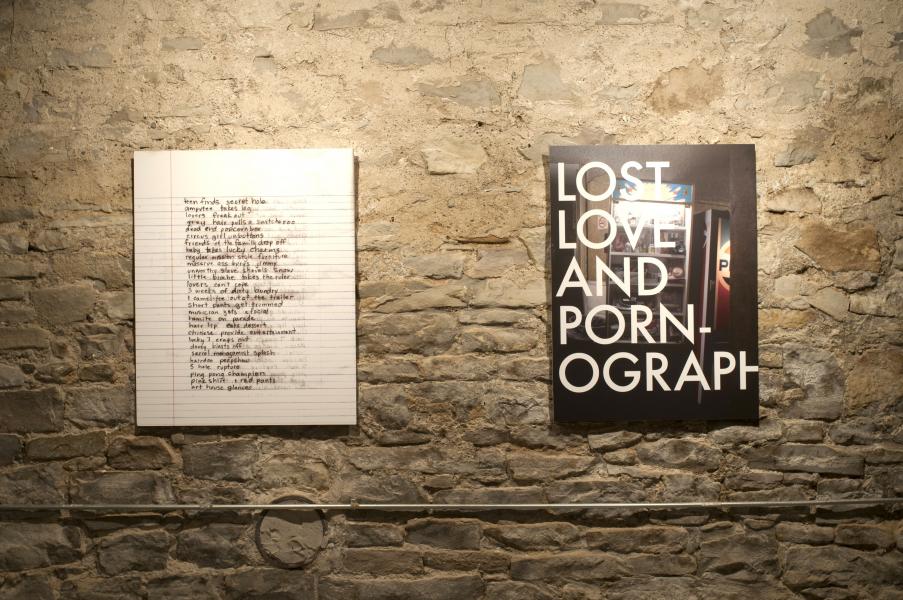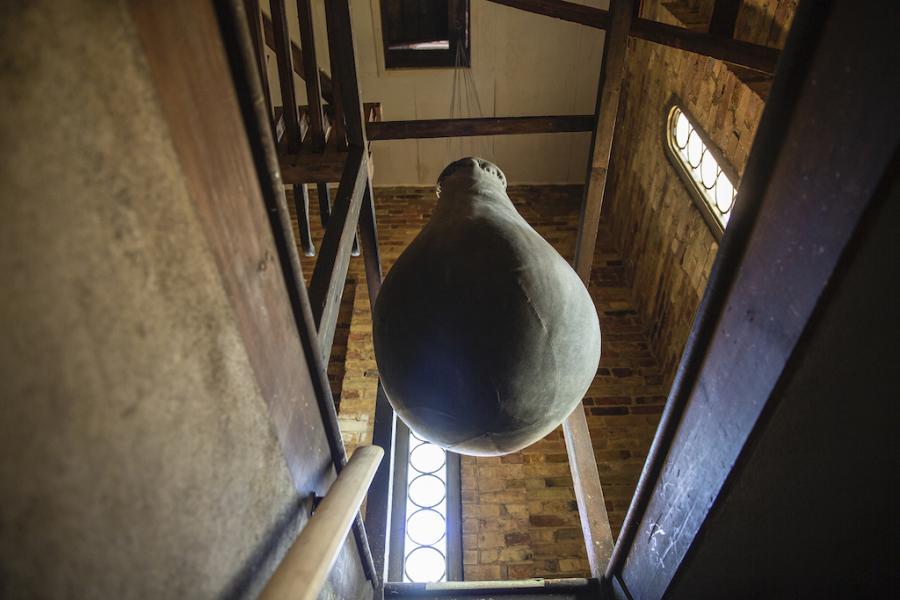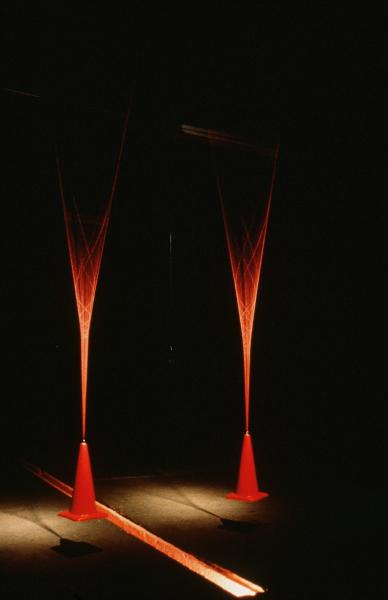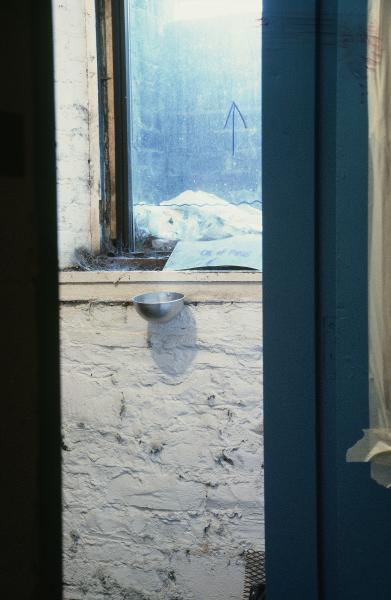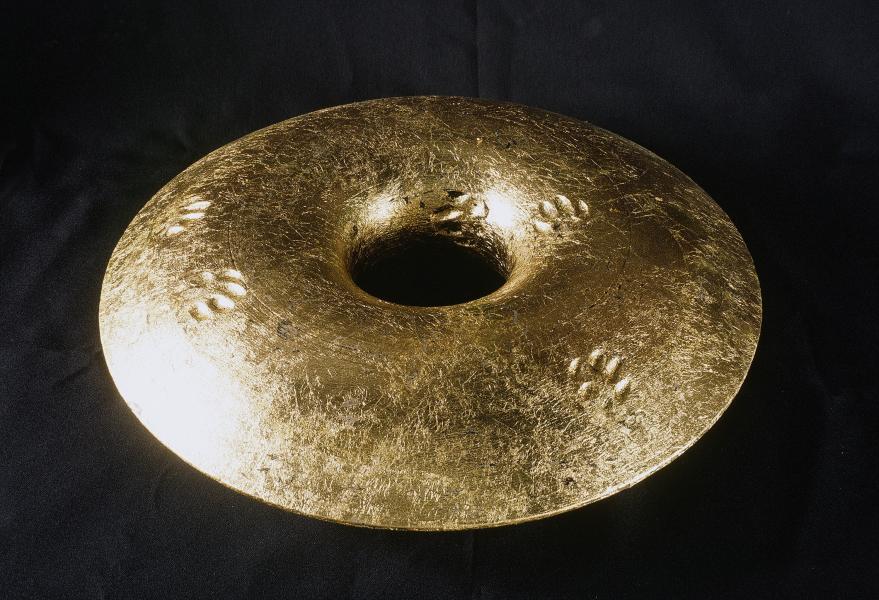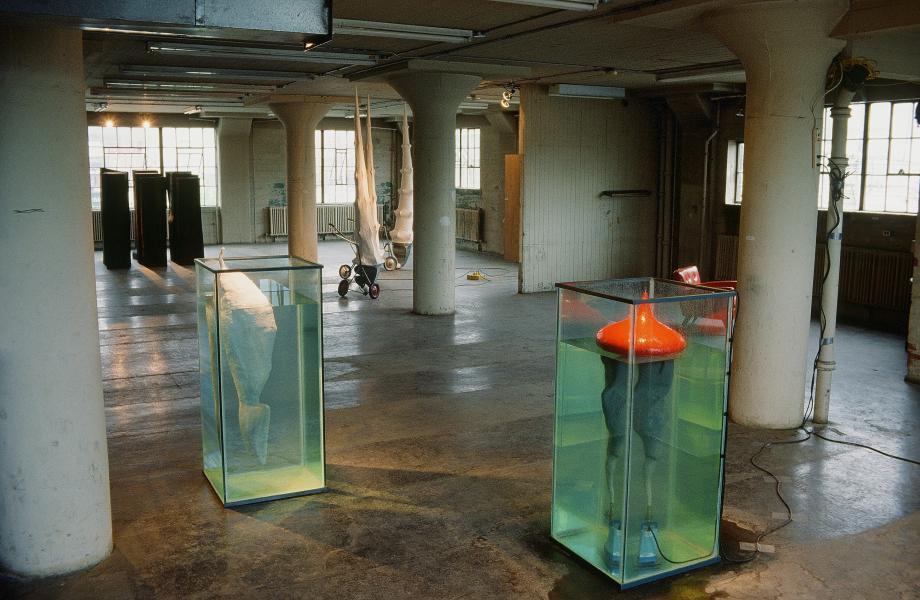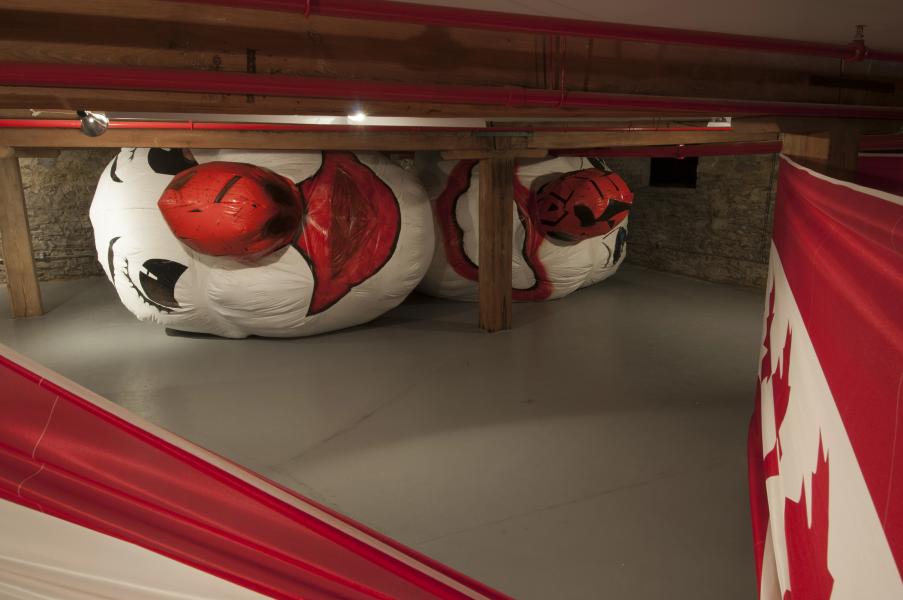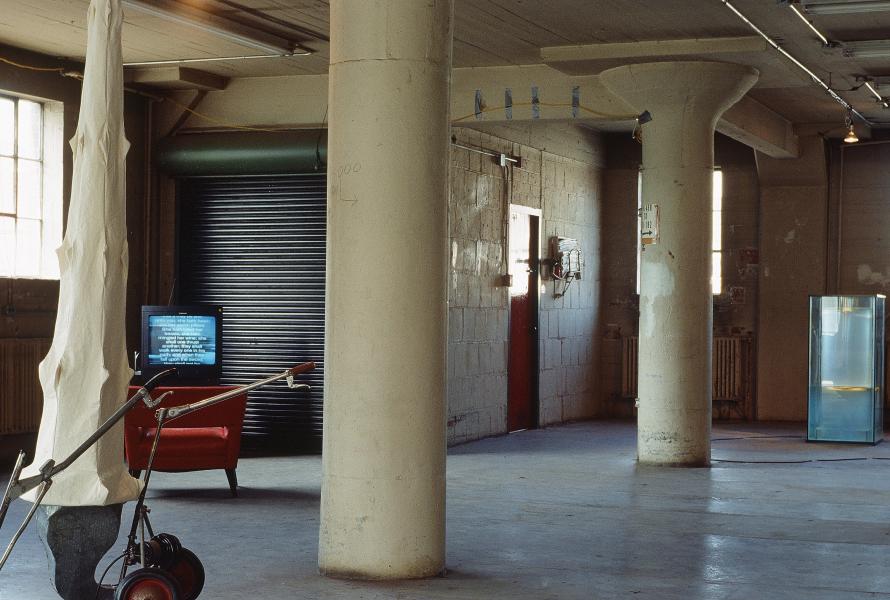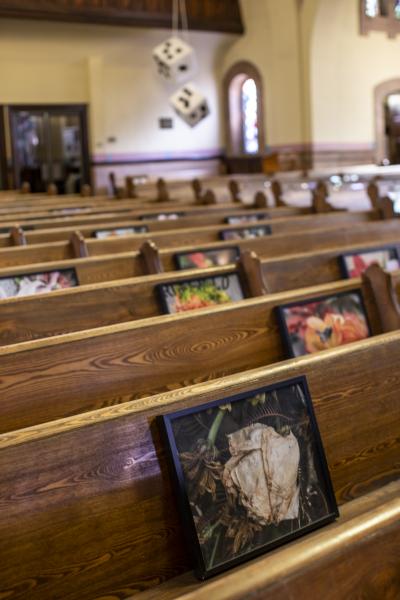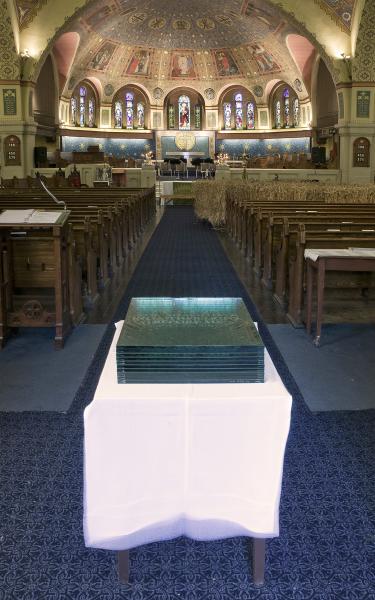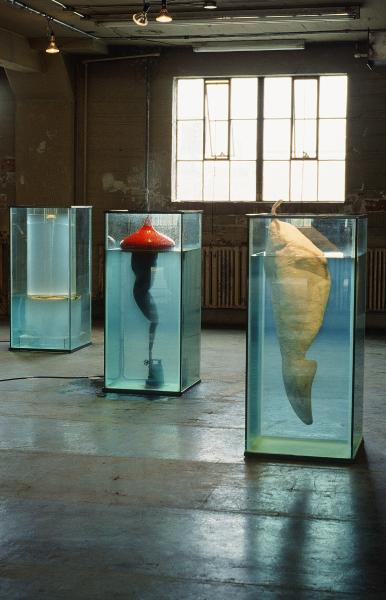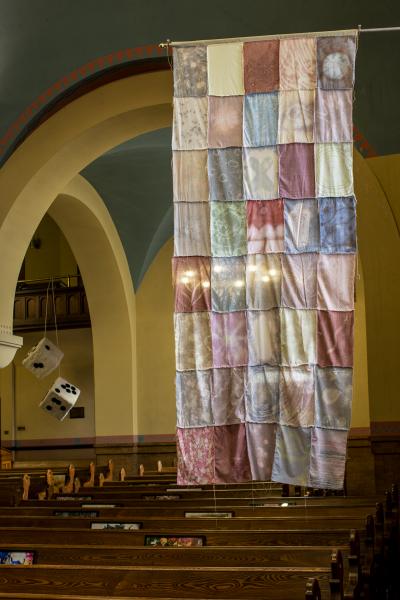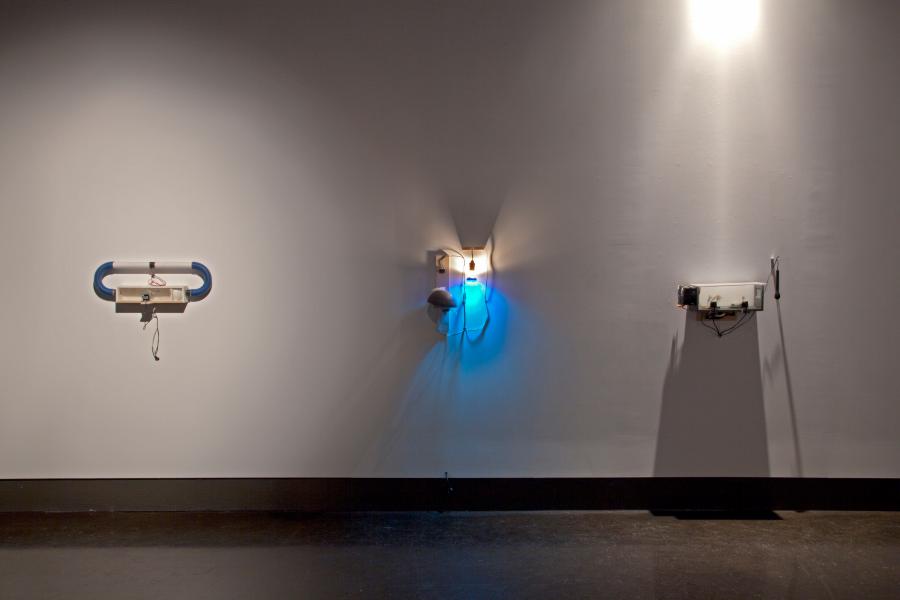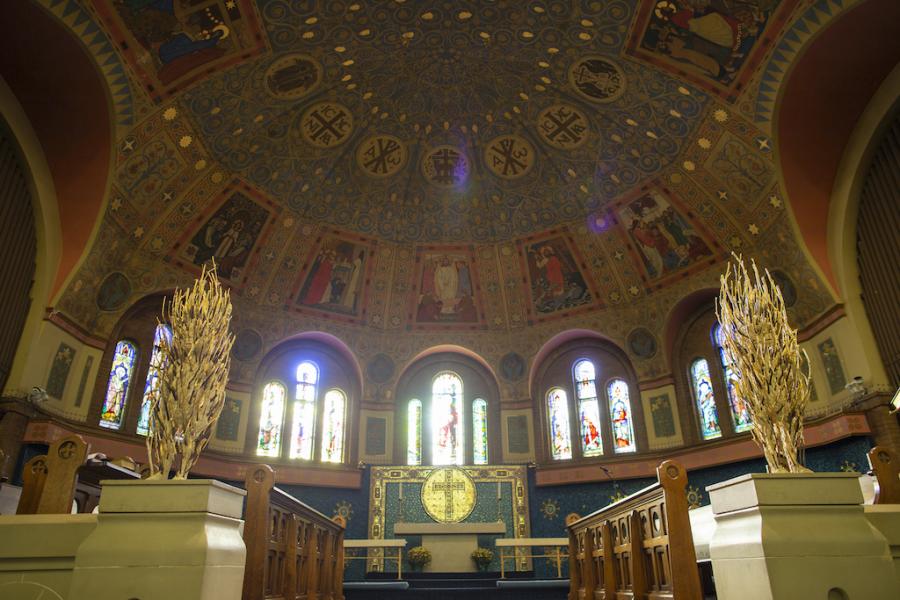basement - approximately 3000 sq ft.
The first NetherMind site was a deep, linear basement space with some niches and small unexpected rooms that projected from the main space. When the group first looked at the site it was dark and dirty; when we turned up to install the exhibition we were disappointed to see that the landlord had cleaned and painted. Some special features included a room with a sunken floor and bricked up broken windows that Tom Dean flooded with fake blood, and a dark claustrophobic vault in which Max Streicher placed five sad, un-inflatedinflatables.
InvitationPoster
Press - Globe and Mail
Press - Globe and Mail
basement & second level - approximately 1500 sq ft per floor.
The landlord initially promised us two adjacent floors at the top of this four storey building. As tenants were found for the newly renovated spaces, we ended up occupying the second floor and the basement. We looked on the bright side: the basement represented the Nether and the upper floor, the Mind. After we had installed the work the basement floor was dug up for some urgent plumbing modifications, and remained that way for the length of the exhibition. Reinhard Reitzenstein embraced the trenches as they added a visceral element to his work, Empathic Nervous Systems.
Label - Nether Beer
Poster
Press - Globe and Mail
Press - Now Magazine
basement - approximately 4000 sq ft.
This long sprawling basement space was cave-like in its configuration, atmoshere, and rawness. As one moved further back through the three distinct chambers, the lighting and mood got darker, with marked temperature changes between the rooms. Occasionally and unpredictably, jets of steam would erupt from the plumbing creating temporary pools on the concrete floor. John Dickson placed his works, Strange Fruit, in the freight elevator vestibule where the space bottlenecked. This forced viewers to come into physical contact with his swollen rubber vessels.
CatalogueInvitation
Poster
Press - Globe and Mail
Press - Now Magazine
Press - Parcours Magazine
Press Release
ground level and offices -approximately 6000 sq ft.
This large, dirty, industrial space had been used to dye fabrics; the main space had trenches inset into the floor which Lyla Rye incorporated into her Untitled installation work. Reinhard Reitzenstein found crates containing large thermometers which played an important part in his piece, Wood Burns at 500 F. John Dickson found a dead pigeon, which he left undisturbed and absorbed into his installation Vertigo. The Catherine Heard had to strategically place the fabric figures of her work, Confessional, to avoid spots where the roof leaked. Max Streicher exploited the height of the space while Mary Catherine Newcomb affixed her plasticine tongue to the freestanding chimney in the space. NetherMind artists had lengthy discussions on whether or not to sweep the floors.
CatalogueInvitation
Poster
Press - Artfocus Magazine
Press - Globe and Mail
Press - Now Magazine
Press Release
basement, ground level, stairwells and balcony.
With its Byzantine revival architecture and Group of seven murals, St Anne’s provided a rich and engaging site for NetherMind’s explorations. The dark, claustrophobic basement created a very different mood from the airy splendor of the church’s main level.
Invitation
Map and Essay
Press - Akimblog
Press - Canadian Art
Press - Toronto Review of Books
Press - Toronto Star
Press - York University
Press Release
St. Anne's Poster
ground level - approximately 4000 sq ft.
This was NetherMind’s first and only exhibition in a gallery. UWAG is housed in a re-purposed industrial building and has many subtle details that hint at its previous history, giving it more character than most contemporary art spaces. With pieces installed on columns and in a storage area, NetherMind tried to approach the site with the same attitude it would a dirty warehouse basement.
Essay - Ivan Jurakic
Invitation
Map & Statements
Press - Imprint
Press - The Cord
Press - The Record
Tattoos
basement - approximately 3000 sq.ft.
For this exhibition, NetherMind collaborated with ART SPIN, who found and secured the venue. The space was located at the rear of what, until recently, had been, an operating flag factory. Lyla managed to secure a roll of Canada flags which she used to create her site-specific piece, Canadian Pale. Tom Dean and Trevor Wheatly collaborated to create Skunked?, a piece that appeared to be a weathered, lawyer’s sign that hung over the exterior entryway to the building. Unfortunately the buildings owner, perhaps failing to see the works humour, made us relocate it after the opening.
Essay - Gordon HattInvitation
Map
Press - Akimblog
Press - Now Magazine
Press Release
ground level, balcony and bell tower
NetherMInd : Elegy mourned the destruction of the environment by anthropogenic climate change. In this exhibition, artists created meditations on environmental destruction and ecological grief through sculptural, photographic, and video installations.
Collective members John Dickson, Catherine Heard, Greg Hefford, Reinhard Reitzenstein, Lyla Rye, and Max Streicher were joined by guest artists, Ed Pien, and Kendra Yee
Catalogue
Essay - Matthew Brower
Invitation
Map & Statements
Poster
Press - Artoronto
Press Release
Video Documentation
Max Streicher is a sculptor and installation artist from Alberta, now residing in Toronto. Since 1989 he has worked extensively with inflatable technology in kinetic sculptures and installation works. He has shown widely across Canada in solo exhibitions in museums such as The Art Gallery of Ontario, Edmonton Art Gallery and the Mendel Art Gallery in Saskatoon. He has been part of group exhibitions at the Museum of Contemporary Art, Taipei, the Museum of Contemporary Canadian Art, Toronto, the Saidye Bronfman Centre, Montreal, Power Plant Centre for Contemporary Art, Toronto and Southern Alberta Art Gallery in Lethbridge. He has completed several international site-related projects in such places as Taichung, Taiwan, Erfurt, Germany, Riems, France and Aachen, Germany, Madrid, Spain and Mumbai, India. His inflatable works are in the collections such as that of the ESSL Museum, Vienna, and Beaverbrook Art Gallery, Fredericton and the University of Toronto Art Centre. He was a founding member of the NetherMind collective. Max Streicher is represented by Ponce+Robles in Madrid, Galerie Miguel Marcos in Barcelona, Gallery Maskara in Mumbai, India, Felix Ringle Galerie in Düsseldorf and Ricco/Maresca Gallery in New York.
maxstreicher.com
I grew up in Montreal and now live close to Toronto. I had art lessons with the nuns as a kid then studied science at University of Toronto before jumping the tracks and getting an BFA from University of Waterloo followed by an MFA from York University. I retain a fascination with the biology (and everything else) of living things and like to muse about relationship between organic structures and intuitive perception/imagination.
I have worked as a sculptor with a large variety of materials - the most challenging forcing a re-enactment of antique agrarian practice. I have had lots of exhibitions - mostly in Canada -, a few public commissions, some prizes and grants, and have been a NM member since 1992. I currently teach at Sheridan College, regularly show work at Loop Gallery (Toronto), and am periodically confused.
newcombalia.ca
Greg Hefford is a multimedia artist from Toronto born 1964. BFA & B. Ed at York and U of T. He is a member of the NetherMind Collective. He has shown locally and internationally (Power Plant, Buffalo, Shanghai, Bangkok) …but not lately. Speech Bubble Sign is on long-term loan to U of T’s Blackwood Gallery. An additional SBS is permanently installed and generously kept alive by Gene Mastrangeli and Meredith Robb at 22 Cunningham Ave Toronto. Lots of grants including a B grant in 1995. Moving past the flaneur phase of collecting, drawing and photographing parts of the street, Greg now works primarily with intervention and installation: adopting others signage and using it to sublimate a more personal content. He is currently trying to write a semi fictional book entitled "Lost Love and Pornography".
www.flickr.com/photos/21082519@N00
Reinhard Reitzenstein was born in Uelzen, Germany in 1949, He studied at the Ontario College of Art, Toronto, Canada. He is based in Grimsby, Ontario, Canada and Buffalo, NY, USA. Reitzenstein’s work has consistently taken him into processes exploring ways to interconnect nature, culture, science and technology. His work crosses several disciplines: indoor installation and sculpture, photography, digitally processed images; large-scale drawings; outdoor tree-based installations and sound art. Reitzenstein has held over one hundred solo exhibitions and participated in some 300 group exhibitions in North America and abroad. He has completed more than twenty public art commissions along with numerous private commissions. His work is represented in over 50 public and corporate collections internationally, among those are, the National Gallery of Canada, the Art Gallery of Ontario, University of Toronto, The University of Western Ontario, Teutloff Collection, Bielefeldt, Germany, CONAC, Caracas, Venezuela, City of Pirkkala, Finland, Fidelity investments, Boston, Mass., Trilogy, Austin, Texas, Tridel Corp.Toronto, City of Toronto Parks, National Capital Commission. He is currently an Associate Professor at SUNY, Buffalo where since 2000 he has been the Director of the Sculpture Program. He is represented by the Olga Korper Gallery, Toronto
reinhardreitzenstein.com
Lyla Rye is Toronto based artist who began her studies in architecture. She works in installation, sculpture, video and photography to explore the experience of architectural space. She received a BFA from York University and an MFA from the San Francisco Art Institute. For over 20 years her work has been exhibited in galleries across Canada and internationally including San Francisco, New York, Adelaide (Australia), Paris, and Berlin. She has exhibited at The Power Plant, Southern Alberta Art Gallery, the Textile Museum of Canada and Olga Korper Gallery among others. She has work in the public collections of the Art Gallery of Nova Scotia, York University, Cadillac Fairview Corporation, The Tom Thomson Art Gallery, the Robert McLaughlin Gallery and an artist garden at Harbourfront Centre in Toronto. She has founded and exhibited with a number of collectives including NetherMind, 5 things, The Tree Museum, hic and Persona Volare. Lyla Rye is represented by General Hardware Contemporary in Toronto.
lylarye.com
Tom Dean studied visual art at Sir George Williams University (now Concordia University) and was a founding member of Véhicule Art Inc and Véhicule Press. Over the next decade he produced texts, video, sculpture and prints, and established a reputation for elaborate multidisciplinary performances.
After moving to Toronto in 1976 Dean began his monumental sculpture project, The Floating Staircase (1978-81) whose remains were resurrected and installed at Mercer Union, Toronto in 1983. Sections of Excerpts from a Description of the Universe (1984-88), an extended serial sculpture, were widely exhibited in the 1980s, notably in Aurora Borealis at the Centre international d'art contemporain, Montréal (1985) and in a solo exhibition at the 49th Parallel Centre for Contemporary Canadian Art, New York (1985). His work was included in the group exhibition All That Matters(1988), which travelled across the country. From 1986 to 1989 Dean continued to exhibit work in New York and Canada.
During the 1990s his work has been presented in many important exhibitions in Canada and Europe. A retrospective of his work from the early 1980s to 1999 was presented at the Art Gallery of Ontario, Toronto (Tom Dean: Selected Works Past and Present, 1999).
Major institutions such as the National Gallery of Canada, the Art Gallery of Ontario, the Musée d’art contemporain de Montréal, and the Musée des beaux arts de Montréal maintain his work in their collections.
www.thecanadianencyclopedia.ca/en/article/tom-dean/
John Dickson is a Toronto-based artist whose mixed-media sculptures and installations explore humanity's tenuous relationship with the natural world. Early works investigated water as a sculptural medium, developing themes with underlying environmental concerns. His interest in working with water led naturally to out-door projects, and to exhibiting in non-gallery situations, with artist collectives such as NetherMind and Persona Volare and with organizations like the Tree Museum and Art Spin. Recent work uses models and live-feed video to re-construct and explore our mediated view of the world. Past projects include Frontier, a public commission for the West Toronto Railpath, Music Box for Toronto’s Nuit Blanche and COLD WAR at the AGO’s Young Gallery. He has shown internationally in the USA, France, the Czech Republic and Denmark, and is represented by Katharine Mulherin Contemporary Art Projects.
johndickson.ca
Christopher Dewdney wrote the catalogue essay for the 1995 NetherMind exhibition catalogue.
Christopher Dewdney was born in London, Ontario, and now lives in Toronto, where he is a professor at York University. He is the author of four books of nonfiction as well as eleven books of poetry. A four-time nominee for the Governor General’s Award, Chris won first-prize in the CBC Literary Competition for poetry. In 2005 his book, Acquainted With The Night: Excursions into the World After Dark was nominated for both a Governor General’s Award and The Charles Taylor Prize for literary non-fiction, and was published in seven countries. He was winner of the 2007 Harbourfront Festival Prize. In 2008, HarperCollins published his most recent non-fiction title, Soul of The World: Unlocking the Secrets of Time.
www.wikipedia.org/wiki/Christopher_Dewdney/
Matthew Brower wrote the catalogue essay for the exhibition: Elegy in 2022 which he expanded for the catalogue: NetherMind : Elegy and Mirabilia (2023).
Matthew Brower is a writer, curator, and educator and has taught at the University of Toronto, York University, and Wilfrid Laurier University. He has curated numerous exhibitions of contemporary art including Threatened, Endangered, Extinct (Open Studio); Mediated Memory (National Art Museum of China) for the Beijing Biennale; Yonder (Koffler Gallery), and Suzy Lake: Political Poetics (University of Toronto Art Centre). He is the author of Developing Animals: Early North American Wildlife Photography (University of Minnesota Press) as well as articles and reviews in Antennae, the Journal of Visual Culture, History of Photography, Photography and Culture, and Society and Animals.
www.matthewfrancisbrower.com
Gordon Hatt wrote the essay for the 2012 exhibition: Mirabilia which was reprinted in the 2023 catalogue: NetherMind : Elegy and Mirabilia.
Gordon Hatt (BA 1983, MA 1985, Art History, University of Toronto) was the Executive Director at CAFKA - Contemporary Art Forum Kitchener and Area from 2008 until 2021. Previously he curated Zone A for Nuit Blanche in Toronto, 2008, was Director/Curator at Rodman Hall Arts Centre in St. Catharines from 2004 to 2007 and from 1988 to 2004 he worked in a variety of capacities at Cambridge Galleries (now Idea Exchange), the last seven of those years as curator of temporary exhibitions. Gordon has been active in the development and the curation of Canadian artists for over 30 years. He has published numerous articles, essays and interviews.
Ihor Holubizky wrote the essay for the 1993 catalogue.
Ihor Holubizky was the Senior Curator at the McMaster Museum of Art and Adjunct Assistant Professor at McMaster University. He has a PhD in art history from the University of Queensland, Australia. Holubizky has held curatorial positions across Canada; at the Art Gallery at Harbourfront/Power Plant Toronto, from 1979 to 1988; the Art Gallery of Hamilton, from 1989 to 1997; the Kelowna Art Gallery, Confederation Centre Art Gallery and Museum London. In Australia, he was a curator at the Museum of Contemporary Art, Sydney, the Art Museum at the Queensland University of Technology in Brisbane, and a contract curator-researcher for the University of Queensland Art Museum, Brisbane. He taught in the New Media Department at the Ontario College of Art from 1986-1991 and has lectured internationally over the past 34 years. Holubizky has contributed to numerous publications and critical journals in the Americas, Europe and Asia-Pacific.
In 1998, Holubizky was awarded a Canada Council senior grant for independent curators and in 2004, an Australia Council grant for a research residency at the Hayama + Kamakura Museum of Modern Art in Japan. He has been a Trustee of the Gershon Iskowitz Foundation since 2010, and was a member of the Iskowitz Prize juries in 1992, 2010, 2011 and 2012.
https://www.aci-iac.ca/art-books/gershon-iskowitz/about-the-author/
Ivan Jurakic curated NetherMind's exhibition at University of Waterloo Art Gallery in 2013.
Ivan Jurakic is the Director/Curator of the University of Waterloo Art Gallery. He received his MFA from SUNY Buffalo and an Honours BA from the University of Guelph. Since 2004 he has curated numerous exhibitions, sat on the curatorial panel for the 2009 Sobey Art Award and curated Zone C for Scotiabank Nuit Blanche 2013 with fellow curator Crystal Mowry. His curatorial practice focuses on multidisciplinary art and installation and he has curated exhibitions by Colleen Wolstenholme, Kelly Mark, James Carl, Laurel Woodcock, Kelly Richardson, Lois Andison, and Roula Partheniou among others. His writing can be found in numerous gallery publications. He is also a principal of TH&B, an artist collective that collaborates on site-responsive projects addressing the intersection of urban and rural environments. He lives in Hamilton.
www.uwag.uwaterloo.ca
Art Spin curated the 2014 NetherMind exhibition.
Art Spin is a curatorial collaboration between Rui Pimenta and Layne Hinton. Art Spin has been operating professionally as an arts presenter for over seven years, activating decommissioned venues and unique public spaces to produce large scale group exhibitions along with curated bicycle-led art tours to showcase a wide range of newly commissioned art programing in unique site-specific settings. Led by Layne Hinton and Rui Pimenta, artists and independent curators, driven by a strong sense of commitment and passion for presenting contemporary artworks in alternative, everyday spaces in order to make its audience’s experiences with art more engaging and exciting.
www.artspin.ca


